Gem is one of the world- leading architecture and interior design firm specialized in ultra-luxury cruise ship design and project management. It's name is based on the initial of architect Giacomo Erasmo Mortola who founded Gem in 1985
In the last 40 years, Gem has played a pioneering role in the cruise industry as coordinating architect and interior designer, designing a several award-winning vessels for a variety of clients leaders in their respective markets. Today Gem is involved in every level of the design and construction of luxury and premium cruise ships as well as smaller expedition vessels, from the pre-contractual phase until the delivery of the vessel


Giacomo Erasmo Mortola
Giacomo Erasmo Mortola graduates in Architecture from the University of Genoa in 1974; in the same year his involvement in the cruise ship industry started with the refurbishment of Sitmar fleet.
In 1985 Arch. Mortola established his own firm Gem; since then, he has created over thirty eight new ships and lead as many refurbishment projects.
In his illustrious career, Arch. Mortola became renowned for his ability to strike the perfect balance between form and function and to blend luxurious aestethics with cutting-edge technologies.
Today Giacomo is at the helm of Gem together with his son Lorenzo.
Lorenzo Mortola
Lorenzo Mortola is an Italian naval architect and Chartered Engineer.
After obtaining a Master degree in Naval Architecture form the University of Southampton he moved in Milan where he completed a second Master degree in Interior Design and started working for renowned architecture and interior design film specialized in hospitality.
In 2012 Lorenzo moved back to Genoa and joined Gem as surveyor for refurbishment projects; in 2016 became involved in new builds as well, focusing mainly on ultra-luxury projects.
Since then he has overseen fourteen multi-million cruise ships refurbishments and seven new building projects. Today Lorenzo is at the helm of Gem together with his father Giacomo
At Gem, creativity thrives through collaboration within our multidisciplinary team. Comprised of architects, interior designers, engineers, lighting designers, our team brings together a diverse range of expertise to craft one-of-a-kind spaces that seamlessly blend functionality with aesthetics.
Through constant dialogue and exchange of ideas, we leverage each team member's unique perspective to tackle design challenges from every angle. From conceptualization to execution, our collaborative approach ensures that every project benefits from a holistic understanding of naval architecture, interior design, and engineering principles. Together, we transform visions into reality, pushing the boundaries of what can be realized onboard sea-going vessels.
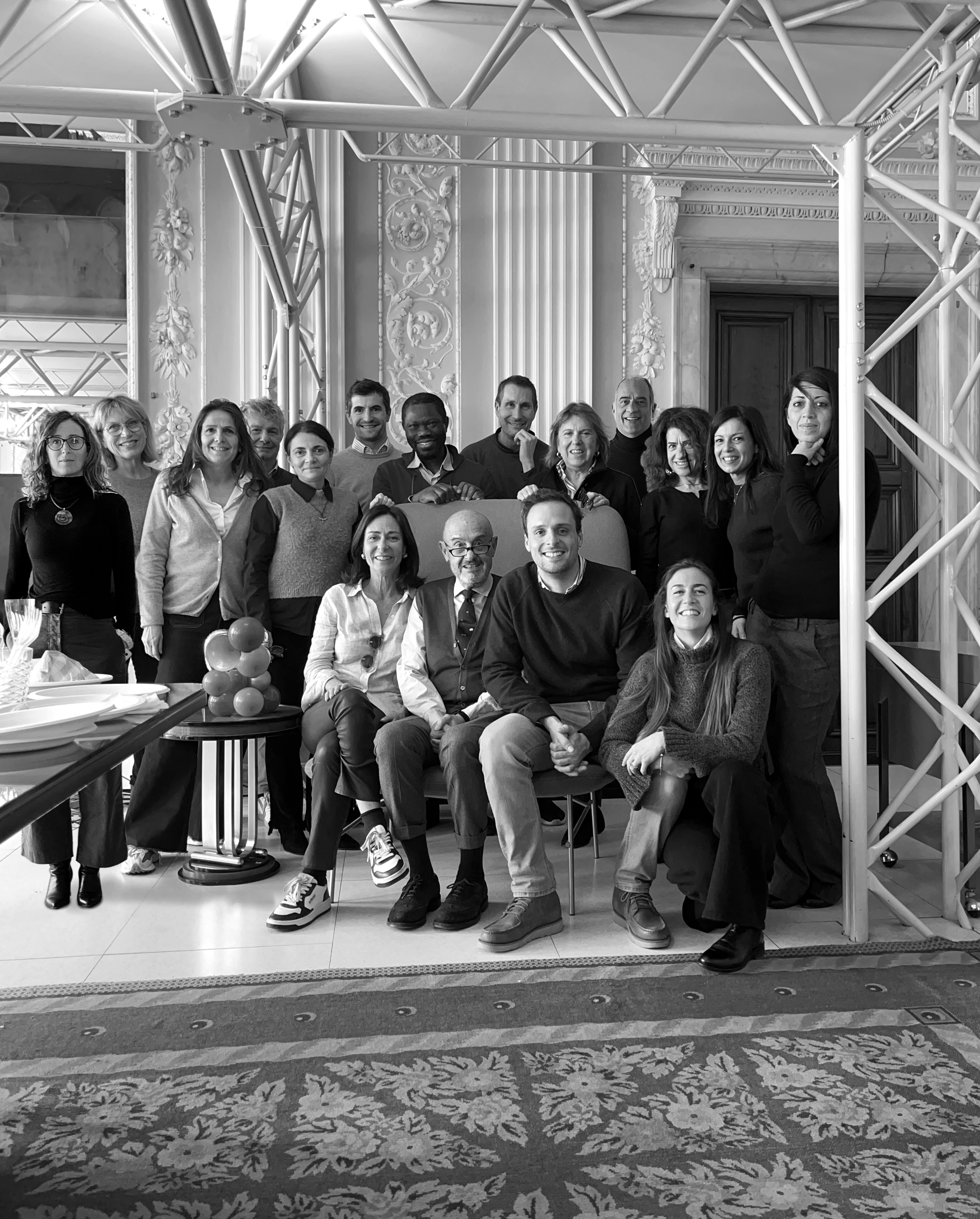
Our Clients
What they say about us
read the press >

Gem P.zza Fontane Marose 4/6 Genova 16123, Italy
T. (+39) 010 582534 E-mail: [email protected] P.IVA : 08709780152
Privacy Policy Cookie Policy Credits: Cecilia Cappelli
Follow us on: LinkedIn Instagram
© 2023 Gem - all rights reserved
The Right Company
Leading naval architecture and marine engineering consultancy, the right people, dedication, integrity and understanding your needs are the keys to success, the right services, from concept to delivery, we cover it all, the right locations, with more than 80 employees, located in eight offices worldwide, highly respected and independent professionals.
Foreship is an independent, highly respected ship design and engineering company, which has provided a broad range of services to the shipping industry since 2002.
Our services range from preliminary studies and sketches through the complete design process all the way to on-site support, supervision and project management during the construction phase.
Newbuilding
Foreship has extensive experience of working directly with shipowners to provide diverse services for the newbuilding market such as concept development, particularly aiming towards the cruise ship industry where we are involved in most of the large passenger newbuilding projects.
Conversions
Approximately half of our projects are conversions, retrofits, and upgrades, including cruise ships, ferries, cargo ships and offshore vessels. Foreship is the world's leading naval architecture consultancy when it comes to large scale, challenging cruise ship conversions.
Sustainability
The concept of sustainability is described in multiple ways. There is no general definition, but the principle is that a sustainable system is one that can be maintained at a certain level over time.
Our consultancy services cover the complete shipbuilding project and the life cycle of a ship.
Recent posts

Foreship makes inviting offer to summer interns
Every year, Foreship opens its doors to Naval Architecture and Marine Engineering students, offering a chance to work alongside industry experts in ship design & consultancy.

03-06 Sep 2024
Next month the Foreship Ltd. team will be attending SMM 2024 in Hamburg, Germany.
Infographics
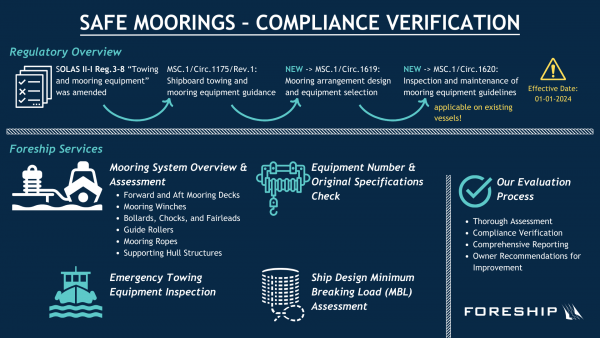
Safe Moorings - Compliance Verification
Starting on January 1st, 2024, the amended version of SOLAS regulation II-1/3-8 “Towing and mooring equipment” and associated guidelines: MSC.1/Circ.1175/Rev.1, MSC.1/Circ.1619 and MSC.1/Circ.1620, will enter into force, shaping the landscape for safe mooring operations.
.png)
Conversion projects: Why choose Foreship?
Ship conversions and newbuilding projects are very different. Foreship is the world’s leading naval architect for large scale, challenging cruise ship conversions.
Case Studies
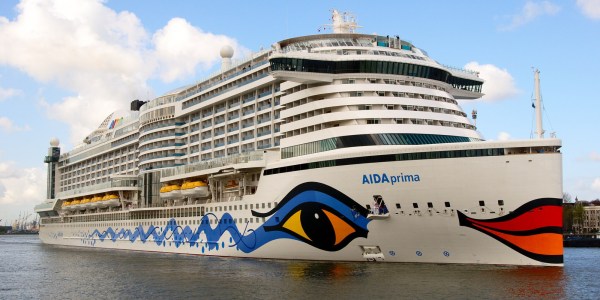
Foreship prime mover in award-winning AIDAprima battery project
AIDA Cruises
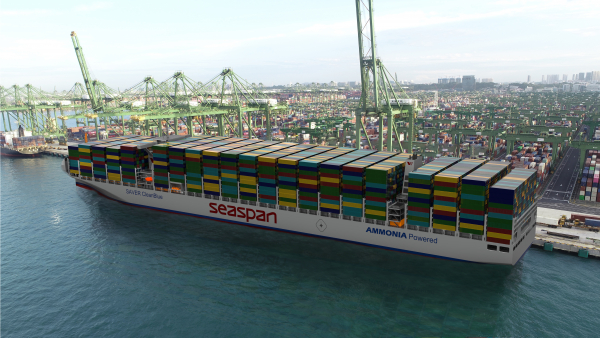
Ammonia-fueled container ship design points the way to low carbon future
Seaspan Corporation
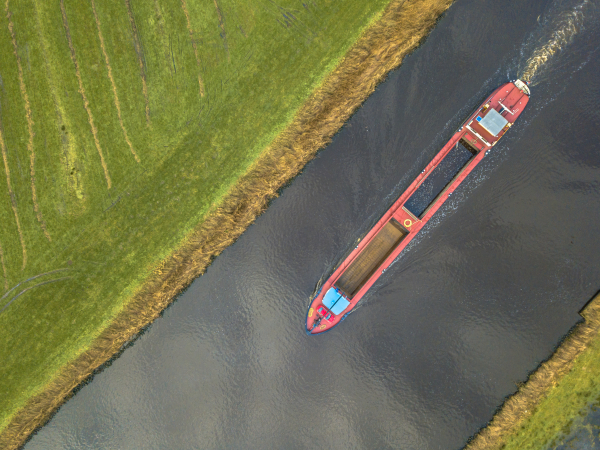
Foreship technical review leads ship battery power inland
Current Direct
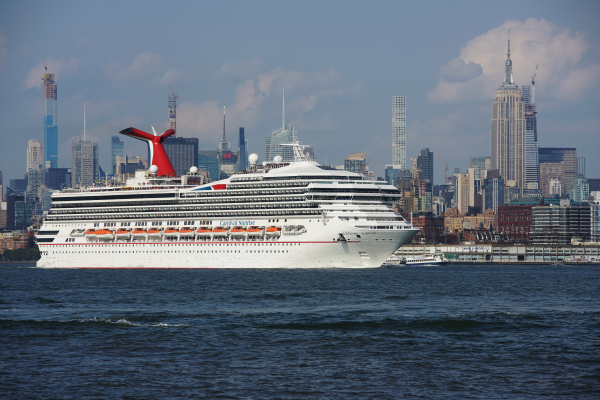
From feasibility to site supervision
Carnival Sunrise

PASSENGER SHIPS
Our services go beyond design to offer total support from our consultants and on-site team, ensuring the smoothest outcome for even the most demanding projects and partners

SHIP DESIGN & CONSULTING
Our mission is to provide bespoke solutions to
the maritime industry with particular focus on passenger ships.
Our services go beyond design to offer total support from our consultants and on-site team, ensuring the smoothest outcome for even the most demanding projects and partners.
LEADSHIP was formed by a group of ship design experts and consultants coming from major northern European design companies.

NAVAL ARCHITECTS
MARINE ENGINEERS
CONSULTANTS

- The Vice Chancellor and Dean
- Facts and Figures
- Our Departments
- Zachry Engineering Education Complex
- Advising and Support
- Degree Programs
- Engineering Academies
- Online Degrees by Department
- Online Courses
- Engineering Global Programs
- Admissions and Aid
- Undergraduate Admissions
- Graduate Admissions
- Transfer Students
- Entry to a Major
- Explore Engineering Career Paths
- Visit With Us
- Student Life
- Find Your Community
- Get Creative
- Interact with Industry
- Solve Problems
- SuSu and Mark A. Fischer '72 Engineering Design Center
- Meloy Engineering Innovation and Entrepreneurship Program
- Undergraduate Research
- Autonomy and Robotics
- Education and Training Research
- Energy Systems and Services Research
- Health Care Research
- Infrastructure Research
- Materials and Manufacturing Research
- National Security and Safety Research
- Space Engineering
- Partner With Us
- PK-12 and Educators
- Researchers
- Reach Our Divisions
Cruises, cargo and carriers: What is naval architecture?
October 9, 2020 By Hannah Conrad
- Ocean Engineering

For the second year in a row, a survey by Bankrate , a leader and authority in the financial industry, has ranked naval architecture and marine engineering as the most valuable majors with a median salary of $90,000 and an unemployment rate of 1.6%.
With such importance placed on naval architecture as a specialty within ocean engineering, the question follows: What exactly is it?
Dr. Jeffrey Falzarano, professor in the Department of Ocean Engineering at Texas A&M University, has the answer. Here are the top five things you need to know about naval architecture.

1. It’s been around for thousands of years.
Naval architecture, a specialization offered in the in the ocean engineering department, is one of the oldest engineering disciplines — dating all the way back to the first manmade raft and canoe. As Falzarano explained, since the Grecian times of Archimedes, scientists were not only creating floating crafts, but studying the buoyancy and stability of them as well.
While it wasn’t called such until more recent years, naval architecture tasks people with creating some of the largest (up to 1,500 feet in length) and most complex moving manmade crafts and systems, like oil tankers, nuclear submarines and cargo ships.

2. It isn’t just about military ships.
Despite how its name might sound, naval architecture is not solely focused on designing ships for the Navy. While that is one aspect, naval architecture is the science of designing boats, ships and other floating structures, such as aquaculture habitats. This includes cruise ships, cargo carriers, personal speed boats and jet skis. While many engineers do work on Navy ships and underwater military crafts, the field of ocean engineering and naval architecture is broad.
“Anything that floats in the water is something that needs naval architects and marine engineers ,” said Falzarano. “One of my areas, for example, is ship maneuvering. When you drive a car, you want to make sure it responds well. It has to turn when you want it to, right? When you drive a ship, it has to respond correctly. And, like cars, sometimes collisions happen. Why? What went wrong?”

3. It puts the ship in shipment.
“I think there's literally tens of thousands of large commercial ships sailing the ocean as we speak — tankers, container ships,” said Falzarano. “Globalization makes opportunities because shipping makes opportunities. Someone makes a product in one country and they want it in another, and you have trade. And people don’t think about naval architecture when they think about shipping.”
But, according to the Organisation for Economic Co-operation and Development, around 90% of traded goods are carried via the ocean. Sea-based shipment only represents 2.6% of total greenhouse emissions, making it cleaner than most other transport options.

4. It is an international and multi-industrial field.
From shipping to submarines to luxury and leisure, the need for experts who can not only design a floating vehicle, but adhere to the international policies and regulations that govern the safety of those vehicles is imperative. Global organizations have been founded — drawing upon the expertise of a wide range of industries — to determine how to protect those aboard floating vessels. It is up to naval architects and marine engineers to understand, abide and strive to better these regulations through innovation and ingenuity.
Additionally, as Falzarano described, because naval architecture is a global industry through trade, building, cruise tourism, personal water transportation, etc., there are many facets for naval architects to find their niche in the field and see the world.

5. It’s continuing to grow and evolve.
“There will always be a need for people to do this,” said Falzarano.
With the evolution and implementation of new technology to the discipline, such as unmanned robotic vehicles and clean energy solutions, naval architecture is continuing to grow and transform the world.
“There are wind turbines out in West Texas, but the real potential is offshore energy because the wind is even stronger offshore and the waves have much more energy in them than wind,” said Falzarano. “My point is, whether it's a ship, a renewable energy device, an oil and gas platform or another floating structure, they all kind of behave the same way.”
With a hand in connecting cultures and continents, bridging industries and ideas, and bringing together people and products, there is still lots of ground to cover.
The Department of Ocean Engineering offers a specialization in naval architecture at both its flagship College Station and its seaside Galveston campus. This unique duel campus setup gives the department access to both world-class research facilities and direct access to the water and coast, offering students a hands-on research and education experience like no other. Learn more about the ocean engineering degree programs offered at each campus .
- Facebook Facebook
- Twitter Twitter
- LinkedIn LinkedIn
- Email Email
- Print Print
Naval Architecture
Providing comprehensive naval design services.
Gibbs & Cox naval architects draw from nearly 100 years of industry experience and technical development to provide a comprehensive set of design services across a variety of platforms. Our naval architecture services span the entire ship’s lifetime, from early stage concept designs through detailed design, shipyard construction support, full lifecycle and sustainment support, ship alterations, service life extensions, and disposal.
Our Naval Architecture Design Process & Development Services
Our engineers combine the use of in-house proprietary naval architecture tools and state of the art software with an extensive technical library to provide accurate naval architecture assessments to our clients.
Key components and outputs of our design process include:
- Overall ship sizing studies and feasibility assessments
- System tradeoff studies
- Preparation of contract guidance drawings and working drawings
- Ship checks
- ECP development
- Preparation of procurement documents
- Selected record plan preparation and updates
- Technical manual preparation and revisions
- Ship system analysis
- Preparation of cost/time/schedule estimates
Additionally, we offer a variety of design and development services, including:
- Research & development
- Concept design services
- Feasibility design services
- Preliminary design services
- Contract / final system design services
- detailed design and Construction services
- Production liaison services
Concept & Feasibility Design
The Gibbs & Cox concept design process involves the development of design alternatives based on client requirements. Our team of naval architects and marine engineers adapts a set of top-level requirements into concept-level definitions to evaluate technical feasibility, cost and performance.
These efforts involve the complete early phase definition of the ship, including:
- Principal characteristics
- Hullform selection and sizing
- General arrangements
- Weight estimates
- Speed, power and endurance calculations
The Gibbs & Cox feasibility design process is an expansion of the conceptual design phase and includes trade off evaluations, typically considering system/subsystem level development that are oriented towards platform-level optimization. Systems engineering requirements at the total ship level are also allocated to the system/subsystem level and to the component level.
Following a systems engineering approach, emphasis is placed on performance characteristics, including:
- Combat system
- Speed and endurance optimization
- Survivability
- Noise and vibration reduction
Gibbs & Cox refines our approach to tailor our focus to suit a client’s key needs and ship requirements.
Typical products developed during the feasibility phase include the following:
- Trim and stability
- Longitudinal strength and midship section
- Electric load analysis
- Cooling and HVAC Analysis
- Machinery arrangements
- Auxiliary machinery arrangements
Gibbs & Cox uses the alternatives developed in trade-off studies to develop data-informed solutions for the design, resulting in a higher-fidelity product.
Preliminary Design
The Gibbs & Cox preliminary design service process includes support to both systems engineering and specific technical areas. The Preliminary Design phase builds on the major ship characteristic/system decisions made during Feasibility Design to achieve a converged baseline design with defined systems requirements.
Objectives of this phase include:
- Refining operational requirements
- Assessing ship performance within cost constraints
- Identifying critical system interfaces
- Establishing the functional baseline of the platform
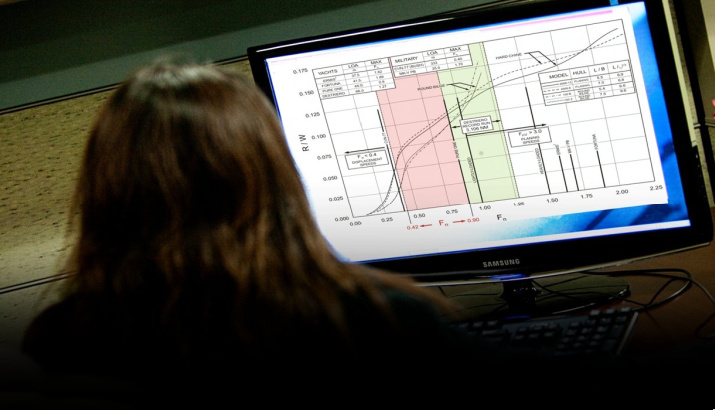
Contract Design
The Gibbs & Cox contract design process evaluates the preliminary design further, resulting in a final system design that has sufficient detail and requirements development to begin the detailed design phase.
The products developed during the Contract Design phase are used by the shipbuilder to develop a cost estimate for bidding purposes. The objectives of this phase are confirmation that the ship design meets the operational requirements and cost, documentation of criteria for acceptance of the ship and identification of technical and schedule risks.
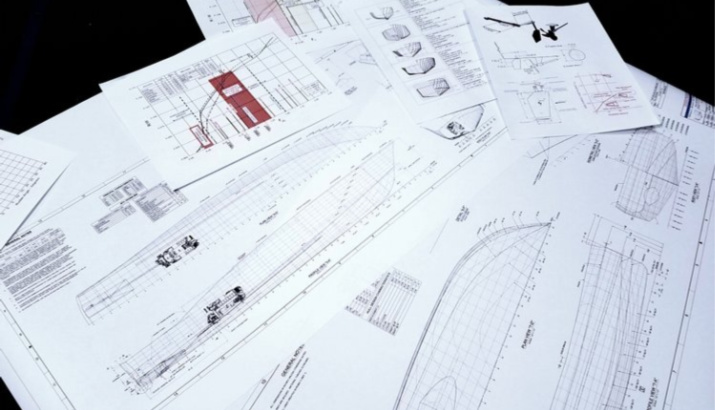
Detailed Architectural Design and Construction
G&C’s Detail Design & Construction solutions are highly tailorable to the needs of the program, shipbuilder, and end-customer. Our efforts seek to maximize producibility and affordability while mitigating risk for procurement, planning, construction, test, delivery, and acceptance.
Generally, a Detail Design program comprises two key phases:
- Functional Design
- Production Design
We follow a proven and systematic approach to Functional Design that entails the maturation of the vessel design to a comprehensive and consistent set of design products ready for customer, class, and regulatory approval. Design decisions during Functional Design use an established tradeoff criteria aligned to the program’s objectives for performance, acquisition cost, and ownership cost. Our tools and processes yield functional design products that are readily verifiable for compliance with the specifications, class rules, regulatory standards, and other contractual requirements.
Production Design develops the 3D product model based on the functional drawings, vendor furnished information, customer furnished information, and build strategy into a configuration optimized for construction. As 3D modeling completes, production drawings and information are extracted and detailed to support complete construction of the vessel in a sequence and format best aligning with the build processes and work centers at shipyard.
For larger ships and more complex vessels, our 3D modeling is typically performed using a zonal approach that follows the module breaks, construction sequence, and other build strategy elements of the ship. As 3D modeling is completed for each design zone, drawings and information are extracted from the product model and issued to production group for planning, fabrication, assembly, and installation. We use the current generation of industry CAD/CAM software for developing and maintaining the 3D product model. Gibbs & Cox has decades of experience using a variety of 3D CAD ship design tools on a broad range of vessel types from simple barges up through complex naval combatants. We augment the capabilities of the 3D CAD/CAM software with other engineering/design tools and processes to deliver a completely integrated detail design.
During 3D modeling, our proprietary Design Control process drives a systematic effort to concurrently arrange structure, accesses, partitions, systems, and equipment within a defined area to produce an optimum arrangement. This includes eliminating physical interferences to reduce construction costs and rework and allows for a greater degree of pre-outfit. Design Control also manages clearances and anthropomorphic modeling to verify effective human-systems interfaces.
During construction, we provide a bespoke solution for the client based on their needs that may include onsite design liaison, manufacturability/producibility engineering, weight control and reporting, configuration management, and test/trials oversight.
Production Liaison (Shipyard) Support
During construction, we provide platform development with on-site and off-site support. Our support capabilities include:
- Project management
- Port engineering
- Field engineering support
- Weight control
- Calculations for lifts & turns
- Launching and docking
- Stability test/experiments
- Test & trials support

Interested in discussing our experience with naval architecture?

- © 2024 Gibbs & Cox, a Leidos Company. All Rights Reserved.
- Terms of Use
- Privacy Policy
- Do Not Sell My Personal Information

We use cookies to offer you the best possible website experience. Your cookie preferences will be stored in your browser’s local storage. This includes cookies necessary for the website's operation. Additionally, you can freely decide and change any time whether you accept cookies or choose to opt out of cookies to improve website's performance, as well as cookies used to display content tailored to your interests. Your experience of the site and the services we are able to offer may be impacted if you do not accept all cookies.

- Careers Home
- Shipboard Opportunities
- Join Talent Community
Architect, Naval Sr
Journey with us! Combine your career goals and sense of adventure by joining our exciting team of employees. Royal Caribbean Group is pleased to offer a competitive compensation & benefits package, and excellent career development opportunities, each offering unique ways to explore the world.
Position Summary
The Senior Naval Architect participates to daily ship project naval architectural routines for specified Vessel Classes during their design and building phases. Participation to concept design process for upcoming new build projects belongs also to his/her focus areas. The Senior Naval Architect works closely with the teams of Maritime Technology and Chief Naval Architect assisting experts with technology development and research in addition to various new build related technical projects such as technical feasibility studies and verification of new technologies.
Essential Duties and Responsibilities
Naval Architecture – Design and Building phases
- Acts as an influencer of naval architecture in the ideation phase for Newbuild concepts
- Participates in development of new projects and liaises with the yard and external design and technical design specialists to gather insights on proposed innovative concepts
- Explores multiple aspirational ship platforms and/or design ideas through feasibility phase, considering main boundary conditions such as technical feasibility, buildability, operability, and affordability
- In-house advisor for Newbuild department on statutory regulations and their direct impact on architectural design. This includes fire safety related topics like space categories, structural fire protection and escapes, assembly stations arrangement, general technical issues, etc.
- Manage assessment and development of ship performance impact on architectural design development including weights and stability, hydrodynamics and speed requirements, ship structure in addition to passenger comfort aspects such as wind comfort, noise prevention, vibration and acoustics, and operational efficiency including passenger flow and lift arrangement.
- Builds and maintains collaboration with team, NB Business & Strategy, Maritime Technology, shipyards, naval architects, architects, brand leaders, and other key thinkers.
- Collaborates with our external partners, consultancies, classification societies, flag states and other industry bodies.
- Actively coordinates the different disciplines, by leading the project general arrangement plan development
- Participates to ships Naval Architectural and regulatory work with classification society, Flag administration, USCG, etc
- Brings basic knowledge by self and maintains relationships with knowledge experts in Classification Societies, Flag State and USCG in ideation phase for feasibility feedback
- Applies knowledge of relevant rules and regulations to the design process
- Assesses and advises specifications, measurements and calculations relevant to ship design.
- Studies, compares, assesses and shares statistical information and analyses across various ships and areas bringing forth observations
- Prepares presentations, supporting documents, e.g. simplified drawings, to improve the understanding by others
- Develops and prepares reports and records related to assignments or projects
- Stays current on relevant maritime industry and technical research and projects; seeks information and evaluates new technology with knowledge experts
- Considering the position and role, the employee is required to perform reasonable and temporally any other job-related duties assigned by their supervisor or management
Technology development
- Participates in design criteria selection and developments for new projects
- Participates to risks management process for new technologies qualification and applies internal process how to identify risks properly at early stage of project
- Feasibility studies for different field of technologies as needed.
Key skills & experience required
- Proficiency in Excel, MS Word, MS Project or equivalent, PowerPoint,
- Working knowledge of various computer aided design programs and analysis programs. Good skills to analyze and develop specifications. Drawings, layouts and other technical documentation.
- Understanding of shipbuilding project and programming processes.
- Operational knowledge of SOLAS, IMO, classification rules and marine standards.
- Fluency in English, other languages as advantage.
- Excellent teamwork skills.
- Good skills for communication and co-operation in multicultural working environment.
- Willingness to travel.
Qualifications
M. Sc. Naval Architect or equal with minimum 8 years of experience in the field of naval architecture in cruise shipbuilding industry.
Physical Demands
The physical demands described here are representative of those requirements employees must meet to perform the essential functions of this job with or without reasonable accommodations. While performing job functions the employee is regularly required to sit, and stand, write, review and type reports, compile data, operate a pc, communicate, listen, and assess information. The employee may move about the office complex, may travel to other office locations and may lift, push, pull or move 10-15 pounds. The employee is occasionally required to walk to the dock, ascend and descend the vessel within a construction site environment. This position may regularly travel domestically or internationally. Visual requirements include distant, close and color vision, and ability to adjust focus.
Work Environment
The work environment characteristics described here are representative of those an employee encounters while performing the essential functions of the job. The environment includes work inside/outside the office, travel to other offices, as well as domestic, international, and shipboard travel. A high noise level is possible if visiting shipboard or offsite locations.
We know there's a lot to consider. As you go through the application process, our recruiters will be glad to provide guidance, and more relevant details to answer any additional questions.
Thank you again for your interest in Royal Caribbean Group. We'll hope to see you onboard soon.
It is the policy of the Company to ensure equal employment and promotion opportunity to qualified candidates without discrimination or harassment on the basis of race, color, religion, sex, age, national origin, disability, sexual orientation, sexuality, gender identity or expression, marital status, or any other characteristic protected by law. Royal Caribbean Group and each of its subsidiaries prohibit and will not tolerate discrimination or harassment.
- View All Jobs
- Royal Caribbean Corporate Site
- Applicants with Disabilities
Copyright © 2021 Royal Caribbean Group. All rights reserved.
Cookie Consent Manager
When you visit any website, it may store or retrieve information on your browser, mostly in the form of cookies. Because we respect your right to privacy, you can choose not to allow some types of cookies. However, blocking some types of cookies may impact your experience of the site and the services we are able to offer.
Required Cookies
These cookies are required to use this website and can't be turned off.
Advertising Cookies
These cookies serve ads that are relevant to your interests. You may freely choose to accept or decline these cookies at any time. Note that certain functionality that these third parties make available may be impacted if you do not accept these cookies.

Cruise Ship Handbook
- © 2023
- Markus Aarnio 0
Helsinki, Finland
You can also search for this author in PubMed Google Scholar
- Introduces the technical principles of cruise ship design and operation
- Covers all technical aspects on existing and future cruise ships
- Includes more than hundred drawings and illustrations
Part of the book series: Springer Series on Naval Architecture, Marine Engineering, Shipbuilding and Shipping (NAMESS, volume 14)
5129 Accesses
1 Citations
This is a preview of subscription content, log in via an institution to check access.
Access this book
Subscribe and save.
- Get 10 units per month
- Download Article/Chapter or eBook
- 1 Unit = 1 Article or 1 Chapter
- Cancel anytime
- Available as EPUB and PDF
- Read on any device
- Instant download
- Own it forever
- Compact, lightweight edition
- Dispatched in 3 to 5 business days
- Free shipping worldwide - see info
- Durable hardcover edition
Tax calculation will be finalised at checkout
Other ways to access
Licence this eBook for your library
Institutional subscriptions
About this book
This book offers a concise, yet comprehensive introduction to the engineering and other principles behind passenger cruise ships. It covers all the important regulations concerning cruise ship design and operation, as well as safety, stability, and environmental aspects. It describes principles of cruise ship hydrodynamics, structures, power plant and propulsion, as well as relevant machinery and control system. Further, it deals with key cruise ship hotel systems, such as air conditioning, freshwater, firefighting, garbage, wastewater and communication systems, and many more. Written in a concise, straightforward style, and including many original drawings, this book offers a unique, informative and inspiring guide, to students and professionals in the field of naval architecture and marine engineering, cruise ship owners and managers, and curious cruise ship passengers alike.
Similar content being viewed by others

Ships and Maritime Transportation

Archimedes and Ship Design

Technical Operations Management
- Shipbuilding Process
- Cruise Ship Design
- Cruise Ship Lifecycle
- Ship Operating Modes
- Damage Stability of Ships
- IMO and SOLAS regulations
- Energy Efficiency Design Index
- Zero-Emission Cruise Ship
- Energy Storage System for Cruising
- Cruise Ship Energy Consumption
- Onboard Control Systems
- Ship Automation System
- Cruise Ship Fire Safety
- Cruise Ship vs. Yacht
- Future Fuels for Cruise Ships
- Diesel-Electric Machinery
- Safe Return to Port
- Ship Air Resistance
- Ship Sulfur Scrubber
Table of contents (10 chapters)
Front matter, what is a cruise ship.
Markus Aarnio
Rules and Regulations
Hydrodynamics, environmental aspects, machinery and propulsion, machinery systems, hotel systems, back matter, authors and affiliations, about the author.
Markus Aarnio is the Chief Naval Architect at Foreship Ltd. in Helsinki. Being employed by a cruise line and naval architect offices, he has worked on hundreds of projects with cruise lines such as Carnival Cruise Line, Norwegian Cruise Line, Royal Caribbean and several others. His experience covers all aspects of cruise ship engineering, from early concepts and specifications to sea trials and delivery, to managing a conversion project. When not working with cruise ships, Markus spends his time in the Finnish archipelago.
Bibliographic Information
Book Title : Cruise Ship Handbook
Authors : Markus Aarnio
Series Title : Springer Series on Naval Architecture, Marine Engineering, Shipbuilding and Shipping
DOI : https://doi.org/10.1007/978-3-031-11629-2
Publisher : Springer Cham
eBook Packages : Engineering , Engineering (R0)
Copyright Information : The Editor(s) (if applicable) and The Author(s), under exclusive license to Springer Nature Switzerland AG 2023
Hardcover ISBN : 978-3-031-11628-5 Published: 11 September 2022
Softcover ISBN : 978-3-031-11631-5 Published: 12 September 2023
eBook ISBN : 978-3-031-11629-2 Published: 10 September 2022
Series ISSN : 2194-8445
Series E-ISSN : 2194-8453
Edition Number : 1
Number of Pages : XXII, 190
Number of Illustrations : 13 b/w illustrations, 109 illustrations in colour
Topics : Mechanical Engineering , Business and Management, general , Transportation Technology and Traffic Engineering
- Publish with us
Policies and ethics
- Find a journal
- Track your research
What is Naval Architecture and Marine Engineering?
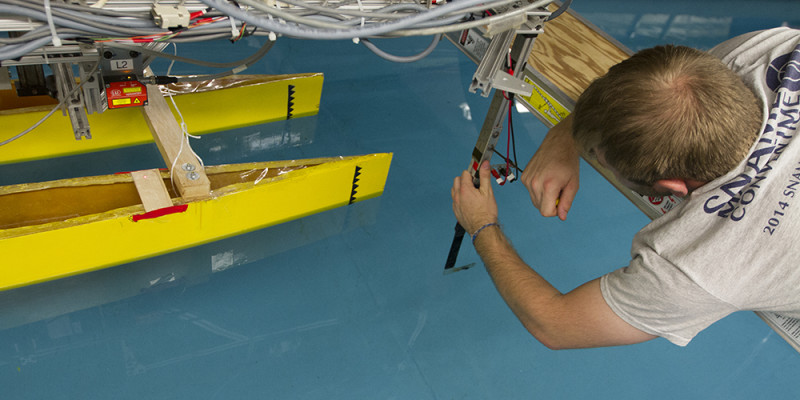
Naval architecture and marine engineering can be described as the design of floating vessels and the integration of their components.
More than 70% of our planet’s surface is covered with water, and our lives are influenced by this fact every day. Whether it’s a large ship carrying cargo across an ocean, a military vessel patrolling the shoreline, a smaller coastal vessel supporting local industries, or a renewable energy device producing offshore electricity, we rely on our water-based industries to support our society.
Using a combination of art and science, naval architects are the lucky individuals who get to design these vessels and determine their shapes and sizes. Using advanced engineering tools and a fine eye for detail, they evaluate the vessels’ stability and maneuvering characteristics, the structures needed to support the forces they’ll experience, and the power needed to propel them through the waves.
Marine engineers are the experts who design the systems that bring these vessels to life. From the largest engine to the smallest part, they’ll determine exactly what is needed to support the vessels’ missions and how best to integrate them within the space available. Like putting a puzzle together, every piece must fit in the right place and nothing can be left out.
Together, naval architects and marine engineers work as a team to design the complete vessel. Imagine that a ship is like a floating city – completely self-sufficient as it crosses the ocean under its own power, producing the power needed to drive the ship, providing the services to support its passengers, and well-engineered to do these things safely and efficiently. Naval architects and marine engineers are the designers and system integrators that make this possible.
What Type of Vessels do Naval Architects Design?
To name a few: cargo ships, high speed sailing and power boats, cruise ships, navy ships, mega yachts, offshore drilling platforms, floating wind turbines, underwater robots, nuclear submarines, and autonomous sailing vessels.
Webb Institute Has a Prescribed Curriculum
All students take the same classes all four years. The subjects are as follows:
Naval Architecture
- Hydrostatics, Hull Form and Stability
- Structural Analysis and Design
- Hydrodynamics, Maneuvering, and Seakeeping
- Resistance and Propulsion
- Design Project
Marine Engineering
- Diesel Engines, Steam, and Gas Turbines
- Auxiliary Machinery and Systems
Engineering and Science Core Requirements
- Electrical Engineering
- Physics, Chemistry, and Materials Science
- Fluid Mechanics and Thermodynamics
- Engineering Drawing and Computer-Aided Drafting
Mathematics and Computer Science
- Calculus and Differential Equations
- Advanced Engineering Mathematics
- Computer Programming and Applications
These course requirements are in addition to core requirements in the humanities, social sciences, technical writing, and oral communication.
Webb Institute is unique in many respects. It offers just one undergraduate program, granting a degree in naval architecture and marine engineering that includes not only a capstone design project, but a senior thesis.
Another unique aspect is Webb Institute’s internship program. Each year during January and February, all students are required to work in the marine industry. Freshmen work in the production departments of shipyards, sophomores go to sea as cadet/observers, and juniors and seniors intern in design and engineering firms. Many of our students intern internationally. Other colleges may encourage students to gain professional experience, but this formally structured program is unique to Webb and a requirement for graduation.
Because few schools teach naval architecture and marine engineering, the supply of naval architects and marine engineers is limited. The placement rate of Webb graduates is 100%. Due to Webb’s practical approach to education our graduates are in great demand, commanding salaries among the top of all engineering disciplines. If you’d like to visit typical corporations that hire Webb graduates, click here .
Upcoming Events
Sustainability in ship design and operations conference 2024, pin it on pinterest.
- Course Descriptions
- Monday Lectures
- Zeien Lecture Series
- Faculty Directory
- Foreign Exchange
- Winter Work Term
- Alumni Regional Events
- Community Portal
- W. Selkirk Owen Award
- Administration
- Board of Trustees
- Diversity, Equity and Inclusion
- Strategic Plan
- News & Events Blog
- Financial Aid
- Tuition & Fees
- Accommodations
- Campus Safety & Security
- Merchandise Store
- Student Services
- Ways You Can Give
- Campaign For Webb
- Heritage Society
- SEA Program
What does a naval architect do?
Would you make a good naval architect? Take our career test and find your match with over 800 careers.
What is a Naval Architect?
Naval architecture is the study and design of ships and other marine vessels. Naval architects use their knowledge of engineering, physics, and materials science to create vessels that are safe, efficient, and seaworthy. They consider factors such as the size and shape of the vessel, its intended use, the type of propulsion system, and the materials to be used in construction. They also take into account the effects of waves, wind, and currents on the vessel, as well as environmental concerns such as fuel efficiency and emissions.
Naval architects typically work in shipyards, design firms, or government agencies. They may be involved in all aspects of ship design, from the initial concept to the final construction. They often collaborate with other professionals such as marine engineers, electrical engineers, and designers to ensure that the ship meets all safety and performance requirements. In addition to designing new vessels, naval architects may also be involved in retrofitting existing ships to improve their performance, safety, or environmental impact.
What does a Naval Architect do?
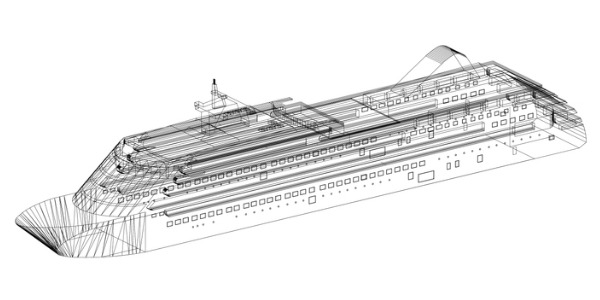
Naval architects possess a unique combination of engineering, physics, and naval knowledge that enables them to create safe and efficient vessels that meet specific requirements. They also play an important role in ensuring that ships comply with international maritime regulations and standards.
Duties and Responsibilities The duties and responsibilities of a naval architect can vary depending on the specific role and organization they work for, but generally, they include:
- Designing ships and marine structures: Naval architects are responsible for designing various types of ships and marine structures, including cargo ships, tankers, cruise ships, ferries, and offshore platforms. They use computer-aided design (CAD) software to create detailed plans and specifications for each vessel.
- Analyzing and testing designs: Naval architects conduct simulations and perform tests to evaluate the performance of ship designs. They use mathematical models to determine the ship's stability, resistance, and maneuverability in different environmental conditions, such as waves, wind, and currents.
- Collaborating with other professionals: Naval architects work closely with other professionals, including marine engineers, electrical engineers, and designers, to ensure that the ship's design meets all safety and performance requirements. They also collaborate with shipbuilders to oversee the construction process and ensure that the ship is built according to the design specifications.
- Conducting research: Naval architects conduct research to identify new materials, technologies, and design concepts that can be used to improve the performance and efficiency of ships. They stay up-to-date with industry trends and regulations to ensure that their designs meet all legal and environmental requirements.
- Project management: Naval architects are often responsible for managing the entire ship design process, from concept to delivery. This includes setting project timelines and budgets, coordinating with other team members, and ensuring that the project is completed on time and within budget.
- Communication: Naval architects must be effective communicators, as they often work on projects with multiple stakeholders, including clients, contractors, and regulatory agencies. They must be able to explain technical concepts and design decisions in clear and concise terms.
Types of Naval Architects Naval architects can specialize in various areas within the field. Here are some types of naval architects and their respective focuses:
- Ship Design Naval Architect: Specializes in designing and developing new ships, including their hull forms, structures, stability, propulsion systems, and overall performance.
- Offshore Structures Naval Architect: Focuses on the design, analysis, and engineering of offshore structures such as oil platforms, floating production systems, and offshore wind turbines.
- Marine Systems Naval Architect: Specializes in the design and integration of various onboard systems, including electrical, mechanical, HVAC (heating, ventilation, and air conditioning), and piping systems.
- Yacht and Pleasure Craft Naval Architect: Concentrates on the design and engineering of recreational boats and luxury yachts, considering factors such as aesthetics, interior layout, performance, and comfort.
- Ship Production Naval Architect: Works on the planning and management of shipbuilding projects, ensuring the efficient execution of ship construction, coordinating with shipyards, and overseeing quality control.
- Naval Combat Systems Architect: Focuses on the design and integration of advanced combat systems and weapon systems for naval vessels, including radar systems, sonar systems, and missile systems.
- Ship Structures Naval Architect: Specializes in the design and analysis of ship structures, ensuring they meet safety, strength, and stability requirements, and optimizing weight and cost considerations.
- Naval Hydrodynamics Specialist: Concentrates on the study of the behavior of ships and marine vehicles in water, including resistance, propulsion, seakeeping, maneuverability, and performance optimization.
- Marine Salvage and Marine Casualty Naval Architect: Deals with the analysis and planning of salvage operations for distressed vessels and structures, including wreck removal and damage assessment.
- Marine Engineer : Naval architects often collaborate with marine engineers to ensure that the design of a ship or marine structure meets the necessary engineering requirements. While naval architects primarily focus on the overall design, hydrodynamics, and stability of the vessel, marine engineers focus on the mechanical, electrical, and propulsion systems that make the vessel operational.
Are you suited to be a naval architect?
Naval architects have distinct personalities . They tend to be investigative individuals, which means they’re intellectual, introspective, and inquisitive. They are curious, methodical, rational, analytical, and logical. Some of them are also artistic, meaning they’re creative, intuitive, sensitive, articulate, and expressive.
Does this sound like you? Take our free career test to find out if naval architect is one of your top career matches.
What is the workplace of a Naval Architect like?
Naval architects can work in a variety of settings, including shipyards, design firms, government agencies, and research institutions. They may work in office settings or in shipyards and other industrial facilities where ships are built and repaired. In these environments, they may be exposed to noise, dirt, and other hazards, so they must follow strict safety protocols and wear protective gear when necessary.
Naval architects may work on a variety of projects, ranging from small pleasure boats to large commercial vessels and offshore structures. They may work on several projects at once, managing different stages of the design and construction process simultaneously. As such, they must be able to multitask effectively and manage their time and resources efficiently.
Naval architects often collaborate closely with other professionals, such as marine engineers, designers, and shipbuilders. They may also interact with clients, regulatory agencies, and other stakeholders throughout the design and construction process. As such, they must have excellent communication and interpersonal skills, as well as strong problem-solving abilities and attention to detail.
Frequently Asked Questions
Architecture related careers and degrees.
- Architectural Designer
- Architectural Engineer
- Architectural Technologist
- Commercial Architect
- Industrial Architect
- Interior Architect
- Landscape Architect
- Naval Architect
- Residential Architect
- Restoration Architect
- Sustainable Architect
- Urban Planner
- Architectural Engineering
- Architectural Engineering Technology
- Architecture
- Interior Architecture
- Landscape Architecture
- Naval Engineering
- Urban Planning
Continue reading

DEJONG & LEBET, INC.
Naval Architects & Marine Engineers
Serving the Marine Industry with Naval Architecture since 1983

DeJong & Lebet, Inc., is a full service naval architectural firm, specializing in the design and conversion of all types of vessel, primarily under 400 feet.
The DeJong & Lebet team is fully capable of designing your complete vessel and guarantee optimum performance in a cost effective manner.

Why choose DeJong & Lebet as your naval architect?
Because the customer's bottom line is our primary concern. We will go the extra mile to make your vessel the most competitive in the industry, without compromising our high standards.

Whether we are designing an air conditioning system or a specialized structural arrangement, our knowledge of today's techniques and use of state of the art computer hardware and software assures that the customer receives a high quality product.
Every product is independently selected by editors. Things you buy through our links may earn Vox Media a commission.
Can Better Design Redeem the Cruise Ship?

I found Virgin Voyages’ new cruise ship Scarlet Lady lolling just offshore from downtown Miami. She beckoned with her streaks of lipstick red, so I walked toward her, across the bridge and into the port (which is a little like walking to La Guardia : possible but not usual), and doubled back, trudging through a sea of parking lots. As I approached the company’s blindingly white, week-old terminal, the ship reared behind it, deck upon glassed-in deck, like a newly sprouted waterfront condo that had drifted across Biscayne Bay. I had come to examine this vast floating object designed to transport thousands into a multi-day fantasy of the yachtsman’s life. A cruise ship is a machine for leisure, and I wanted to know how it worked.
Scarlet Lady represents the first phase in Virgin’s expansion from air, land, and space into sea. A near-identical copy, Valiant Lady , will start sailing from Barcelona in May, and two more are in the works. With a capacity of 2,700 passengers and 1,160 crew, these $700 million babies are not the biggest, fanciest, or costliest of their ilk, but they may be the most fanatically designed. As soon as I stepped onboard (nose swabbed, vaccine cards shown, mask in place), I saw that hardly a square inch had been left to negligence or chance. The elevator waiting areas had no interest, and glimpses into areas where the crew lurks suggested that, as with all theatrical settings, the back-of-house is bare and basic. But the rest of the fit-out manifested the efforts of a dozen architecture and design teams, all managed by Virgin’s chief cat herder, Dee Cooper. Her job was to align all these different creative spirits with the corporate brand — to patrol the border between bold and tacky, obvious and crazy.
And so the jogging track runs along its own red-steel catwalk (by Concrete Amsterdam) elevated above the main deck, the better to avoid collisions and the vibrations of pounding heels. Hammocks, hand-woven in Thailand from flameproof synthetic cable, hang everywhere, combining contemporary relaxation technology with a soupçon of Moby-Dick . Both the cardio gym and the weight room have views of the boundless ocean, so you can feel small while you get big. On the VIP-only deck, dichroic glass panels throw multicolored glimmers on the white lounge beds. Diners can choose between the chrome-and-glass skinny chic of Test Kitchen (“part cooking school and part restaurant”), designed by Concrete Amsterdam; the indigo-and-violet moods of the haute Mexican restaurant Pink Agave, by Tom Dixon’s Design Research Studio; and a fistful of other food habitats. Roman and Williams’ The Manor is a soothing forest-green den, perfect for a quiet old-fashioned — until you walk through a knockoff of a Yayoi Kusama “Infinity Mirror Room,” with stars glittering above below and all around, and into the sensory-overload nightclub. Inviting textures pop up everywhere: plush ottomans, metal partitions that look like they’ve been perforated by a machine gun and beaten with hammers, acres of fake leather, fake wood, synthetic moiré hangings, and assorted other materials that give the impression of luxe while also meeting the fire code’s requirements for industrial toughness. Virgin has virtually eliminated cheap primary-colored plastic with two sweeping prohibitions: no single-use disposable containers and no passengers younger than 18. In the company’s branded universe (though not in the real world), adult apparently means sophisticated .
The Roundabout, at the center the ship.
The Wake, one of the onboard restaurants.
The Red Room bar.
Private terrace in one of the themed suites.
The Pink Agave.
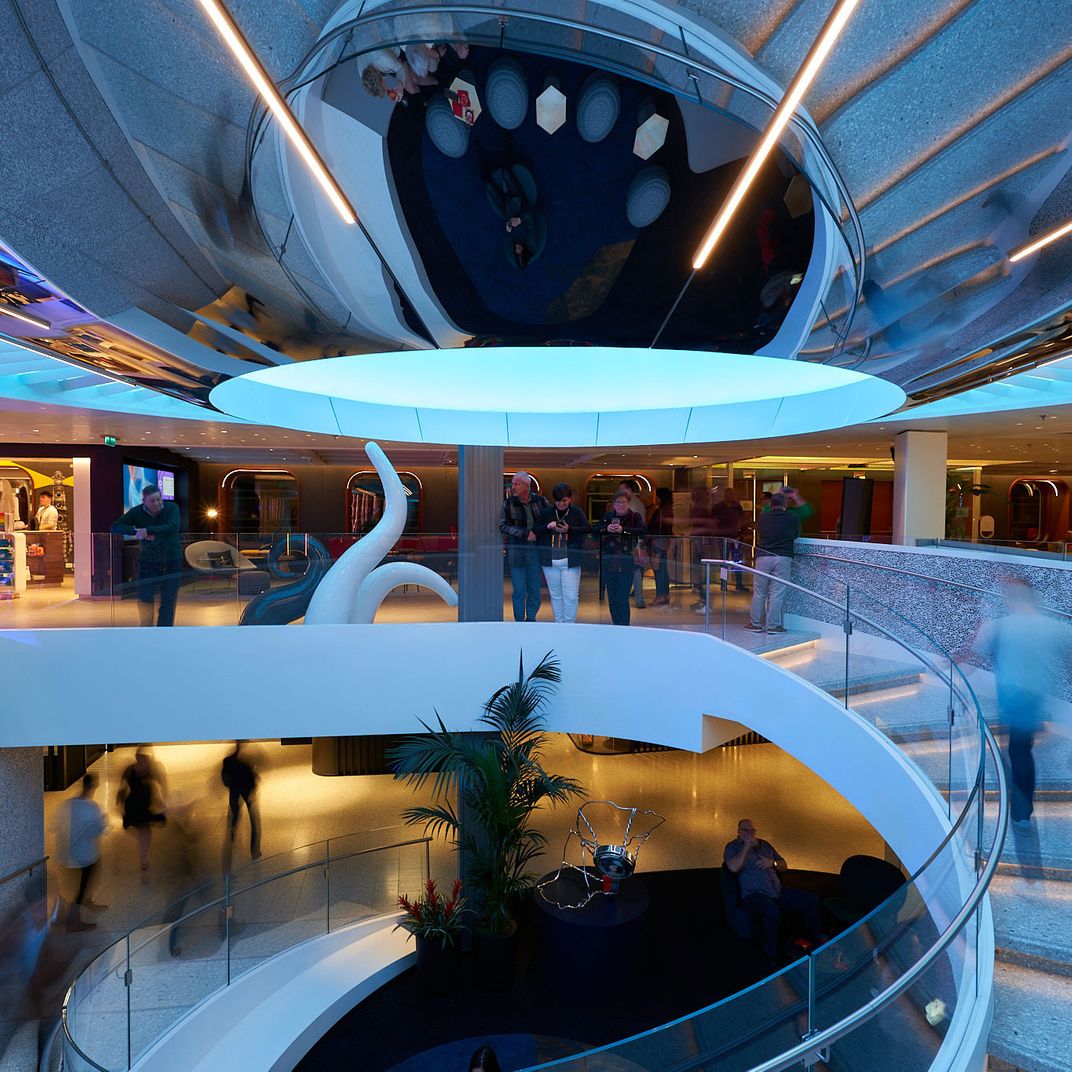
Designing a cruise ship is an idiosyncratic challenge, a mixture of technical givens and carefree pleasure. As in hospitals, bridges, and oil rigs, the overall structure and minute details are governed by engineering, efficiency, safety, and cost. Unlike those facilities, though, the function of a cruise ship is enjoyment (or rather, the profit that flows from providing enjoyment). The trick is to make passengers feel like they’ve been handed an all-access pass to 110,000 tons’ worth of luxury, freedom, and self-indulgence. And so a cruise ship is a complete habitat, its culture constant, its boundaries clear and absolute, its population flowing in and out in regular tidal patterns. At sea, it provides plenty of food and comfort but no escape, which raises the stakes on each design decision.
The Scarlet Lady has a reserve of regal suites pushed out over the bow, each with an expansive terrace. Most of the cabins, though, are tight, with strokes of glamorous lighting and clever design — beds that swivel into sofas, for example — to compensate for the scant square footage. That’s deliberate, both because it increases the number of passengers (“sailors” in Virgin parlance) who can be packed onboard and because it nudges them out into public areas to mingle and drink. But people have different appetites for crowds and rowdiness, and designers had to accommodate all-night dance-partiers, slot-machine aficionados, and those who prefer to spend their evenings murmuring over a cocktail. Even on the outdoor decks, where there is nothing much to do besides lie in the sun and drink, passengers can search out varying degrees of intimacy or public display. In that sense, a ship is a miniature city.
As I toured the various levels, guided up stairs and around corners by Virgin staff so that my sense of the layout grew ever shakier, I saw that exploration is part of the shipboard experience . The interlocked designs must be complex enough to provide multiple routes and destinations, but simple enough to avoid frustrating disorientation. The result is that the decks and bars where the indolent can spend all day in near immobility are also transit points for the restless. That makes a ship like this an eavesdropper’s paradise. It’s engineered so that you can look down on people who forget there’s anything above them but open sky. Privacy is always partial.
I am not the cruise industry’s target audience. Spending days on a floating version of a Las Vegas hotel in order to share a beach with the same several thousand traveling companions who crowd the onboard hot tubs, the slot machine, and the bottomless dinner plate — this is not my idea of a good time. Sea monsters like Royal Caribbean’s new 7,000-passenger Wonder of the Seas strike me as a manifestation of the global addiction to bigness, the malady that has bloated pickups , stretched skyscrapers, widened highways, blocked the Suez Canal , engorged stadiums , jammed Ottawa with 18-wheelers, and even supersized demolitions . Cruise ships pollute the places they visit and, over the years, have battered Venice so badly that the government had to (sort of) ban them from the lagoon. And then there’s the efficiency with which the shipboard lifestyle promotes a lively assortment of respiratory and gastrointestinal illnesses .
Even so, I’m impressed by the imaginative range of this self-contained world, and though I’d probably start eyeing the lifeboats after the first 24 hours, I get the appeal of suspending reality. With all its mood-lit nooks and carefully constructed ambiances, Scarlet Lady is a set on which passengers can act out the scripts they write for themselves. A cruise depends on a stack of brittle illusions: that food is free, rather than prepaid; that wood is wood; that the pool is a pool, rather than a wading tub a few inches deep. (A volume of water large enough to swim in would have to be placed down in the hold, not an upper deck, to avoid destabilizing the vessel.) And so if the ship has a heart it can perhaps be found in the Red Room, the versatile theater designed by WORKac. It, too, can be whatever performers want it to be. Seats get deployed on movable risers, the stage retracts, an overhead lighting grid can shine on any corner, and the walls — red, layered, backlit, and wavy — contribute to the excitement. “You might see a fashion show with the audience on both sides, then come back for a rock concert with a mosh pit, and the next night it’s a regular theater,” says Dan Wood, one of the firm’s founders.
Wood and his partner (in life and business), Amale Andraos, had lofty goals for their first foray into ship design. Before getting the assignment nearly a decade ago, Wood had coincidentally taught an architecture studio inspired by Le Corbusier’s fascination with ocean liners in the 1920s . The guru of modern architecture aspired to translate the streamlined efficiency of naval design into onshore housing. A century later, Wood saw cruise ships as deeply democratic places, where people of many races, ages, and economic classes come together, potentially a source of lessons for the contemporary city.
When it came time to work on an actual vessel, Wood and Andraos hoped to push the core technologies toward greater sustainability, an effort as paradoxical as the concept of clean coal. “We were asking whether we could reinvent a system at that scale,” Andraos says. “But that ship had sailed.” They soon discovered that cruise-ship design is shackled by a matrix of international regulations, shipyard practices, and pre-certified materials. All the architects involved in the project had to be schooled by the Genoese guru of naval architecture, Giacomo Mortola, who has more than 70 new or renovated cruise ships under his belt. They learned that a vessel is made of steel plates like Lego pieces, assembled in multiple shipyards at once. Chunks of Scarlet Lady were fabricated in Romania, then towed to Genoa and welded together.
A signed contract triggers an unstoppable process in which every delay or deviation from the norm has a price, ranging from huge to prohibitive. “Timing is extremely important,” says Mortola. “One delay causes others, and then they start to overlap.” Virgin played a risky game by recruiting so many disparate designers — “A lot of prima donnas and big egos,” Mortola says — and then confronting them with the basic truth that all their imaginative flights had to fit in the same steel box. But that cage is not much more unwieldy or restrictive than a land-bound city. Le Corbusier wanted architects to see ships as examples of unadulterated engineering, beautiful in their bareness. Today’s architects might study Scarlet Lady for the opposite lesson: to see how much freedom can flourish within rigid constraints.
- cruise ships
- scarlet lady
- architecture
- street view
- new york magazine
Most Viewed Stories
- The Hoopla Over Ho-Hum
- Park Avenue’s Park Is Coming Back. Partially. Eventually.
- The Kushner-Klosses Buy a Precarious Malibu Landmark
- The Billionaire vs. the Old Money
- The Flatiron Will Go Condo
- What Even Is a Buyer’s Market These Days?
Editor’s Picks

Most Popular
What is your email.
This email will be used to sign into all New York sites. By submitting your email, you agree to our Terms and Privacy Policy and to receive email correspondence from us.
Sign In To Continue Reading
Create your free account.
Password must be at least 8 characters and contain:
- Lower case letters (a-z)
- Upper case letters (A-Z)
- Numbers (0-9)
- Special Characters (!@#$%^&*)
As part of your account, you’ll receive occasional updates and offers from New York , which you can opt out of anytime.

What Does A Naval Architect Do?
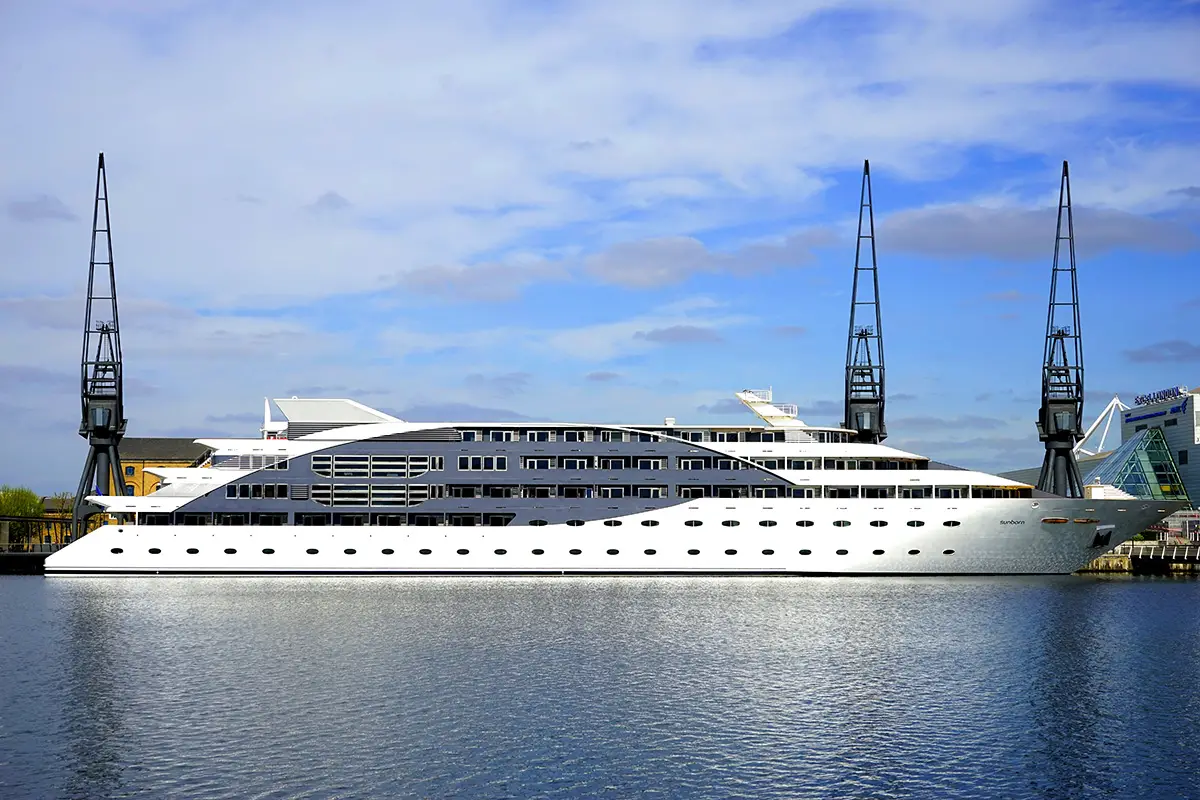
A naval architect is a highly skilled engineer who designs, constructs, and maintains different sorts of marine vessels.
These include merchant ships like oil or gas tankers, cargo ships, ferries, cruise ships, etc. Apart from this, naval architects also look after manufacturing and designing or even repairing ships, yachts, powerboats, steamers, tugs, fishing boats, Warships like Frigates, Destroyers, Aircraft Carriers, Amphibious Ships, etc. Submarines and underwater vehicles, Offshore Drilling Platforms, Semi Submersibles, FPSOs. Special aircraft that are designed for water landings are also designed and built with the help of a naval architect.
Naval architects’ job does not restrict to only designing a marine vessel. They have to usually oversee and even help with the building process. While doing so, they can quickly and accurately catch and correct any shortcomings of the construction. They also evaluate how the ship does during trials both at the dock and at sea and change the design as needed to make sure the ship meets national and international specifications.
- A naval architect conducts extensive discussions with the client to evaluate his needs. He and his team then determine the basic characteristics of the intended marine vessel like weight, size, type of vessel, and purpose.
- Once the above step has been done, a naval architect and his team discuss the design of the marine vessel with the help of sketches and intense brainstorming.
- After the broad design has been agreed upon, the naval architects design the hull and ship.
- Once the superstructure has been designed, the layout of the ship’s interiors is designed.
- The naval architect also has to consult with marine engineers for crucial sections of the ship such as boiler room equipment, HVAC, refrigeration equipment, and propulsion.
- The naval architects then present the final detailed design of the vessel covering every minute part.
- Once, the design has been approved other teams takeover to build and test prototypes and suggest any changes if required.
- A naval architect also evaluates the ship’s performance trials both at the dock and at sea and rectifies the design if needed.
Also read: How To Become A Naval Architect?
Additional Aspects Required For A Naval Architect
Naval Architects have to be creative. They must have a deep understanding of all aspects of ship design – function, design, and safety. Since they have to head a team, they should have the leadership skills to build a cohesive and friendly work environment.
Naval architects should also be proficient in maths and modeling so that the vessel designs meet all national and international safety standards.
A ship, boat, or offshore structure must be stable, seaworthy, and have adequate strength in all weather as well as the hydrodynamic (and, for sailing craft, aerodynamic) performance to give economic propulsion and safe and comfortable motion in all sea states. The design process demands the extensive employment of computer-based information and communication systems.
Naval architects should always be in good terms with the team as it is extremely vital to establish firm team coordination and manage things accordingly. If you want to be a successful naval architect, then you must have the following characteristics present in you:
- Patience and understanding
- Time-management
- Good leadership qualities
- Good communication skills
- Man management
- Observant for the minute details
- Tolerance to withstand pressure and stress, so that you can work calmly in every situation.
The life of naval architects is thrilling and full of challenges being thrown. You will constantly learn and adapt new skills throughout your journey, things you never knew you could do before.
Also read: Ocean Engineering vs. Naval Architecture
Jobs & Career Prospects Of A Naval Architect
Some positions that naval architects hold worldwide are:
1) Marine engineer (Engineering/Stability/Systems/Structural)
2) Marine Surveyor
3) Marine Consultant
4) Production Manager (in shipyards)
5) Offshore Structures Designer
These are some of the roles that a naval architect can play. There is a wide range of roles that are offered to naval architects, which depends on the organization.
Salary of A Naval Architect
The average salary for a naval architect in the USA is around $90,000 to 150,000 per year. This can vary with experience and country.
Eligibility Criteria to Naval Architecture
The number of academic institutions that provide courses related to this industry is only numbered, but in the coming times, keeping in view the growth of this industry over the past few years, you will notice more number of institutes offering courses. It will emerge to become one of the promising careers. You can go for a bachelor’s degree from the universities offering naval architecture, including B.Tech.
Apart from this, you can also pursue any specialization out of the following- ship design, structural design, marine structures, hydrodynamic design, and offshore structures design.
Here are some of the top reputed universities offering courses in this field.
Top Universities For Naval Architecture In World
- Osaka University, Japan
- The University of New Orleans, USA
- University of Southampton, UK
- University of Strathclyde, UK
- University of Michigan, USA.
Top Universities For Naval Architecture In India
- Indian Institute of Technology, Kharagpur ( IITKGP )
- Indian Maritime University, Visakhapatnam Campus ( IMU, Vizag )
- Indian Institute of Technology, Madras (IITM)
- Academy of Maritime Education and Training
- Delhi Maritime Academy
- CUSAT – Cochin University of Science and Technology
- Andhra University, Visakhapatnam
- School of Ocean Engineering, VELS Institute of Science, Technology and Advanced Studies
- IMA – International Maritime Academy
To qualify for the above Indian universities you need to go through their terms and conditions, like some demand clearance of IIT-JEE and so on. It depends on the university criteria of selection.
These universities provide world-class opportunities for higher education and research in the field of naval architecture
Similar Posts
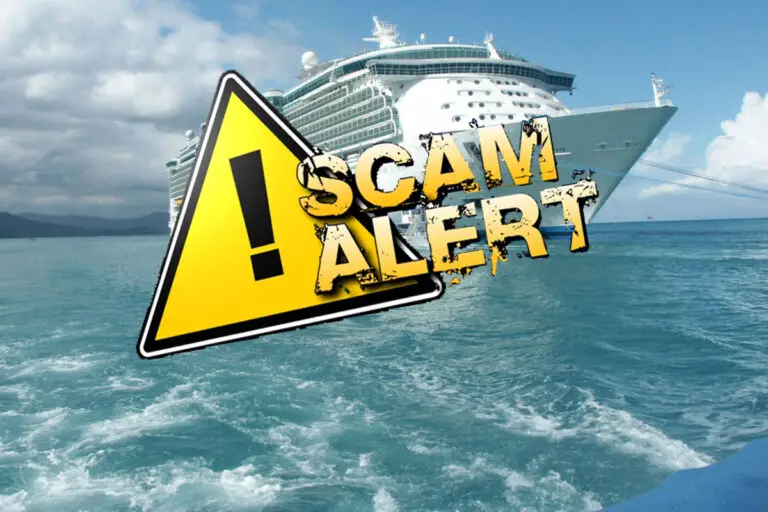
Types Of Marine Recruitment Scams
Job recruitment scams are very common across the world in all industries. Due to high-paying jobs, the marine industry is especially plagued by this menace. Conmen and fake companies leave no stone unturned to rob unsuspecting job aspirants of their money by using different types of marine recruitment scams. These marine job scams are specifically…
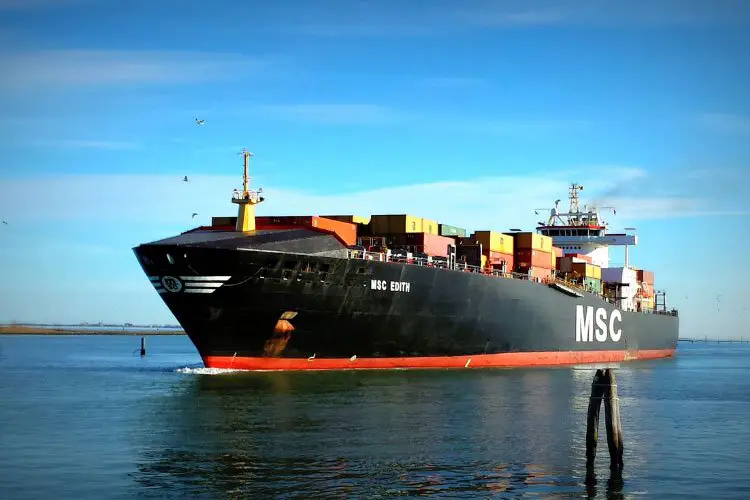
How To Find Out If A Shipping Company Is Genuine And Worth Working For?
A seafarer has to be very cautious before applying for or taking up any job offer. It is very crucial to find if the shipping company is genuine and worth working for. The Internet has made it convenient for people to find their desired jobs with the ease of sitting at home. It has taken…
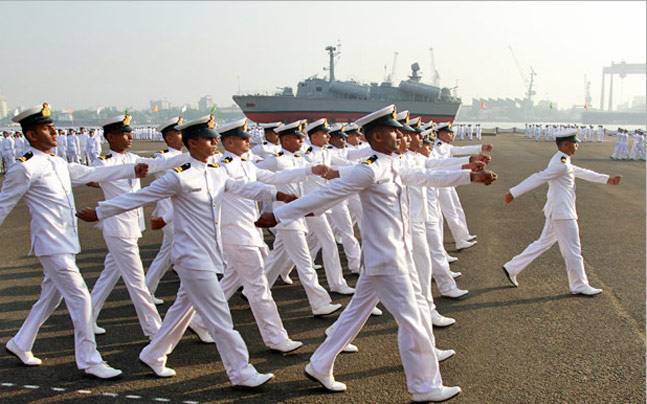
How To Appear For Merchant Navy Competency Examination Abroad (UK)?
Every year, many candidates appear for Merchant Navy Competency Exams conducted by Mercantile Marine Departments in Indian exam systems found at various ports across the country and governed by the central government via the Directorate General of Shipping. These examinations adhere to the Standards For Training Certification and Watchkeeping 2010 (STCW). Still, many Indian seafarers…
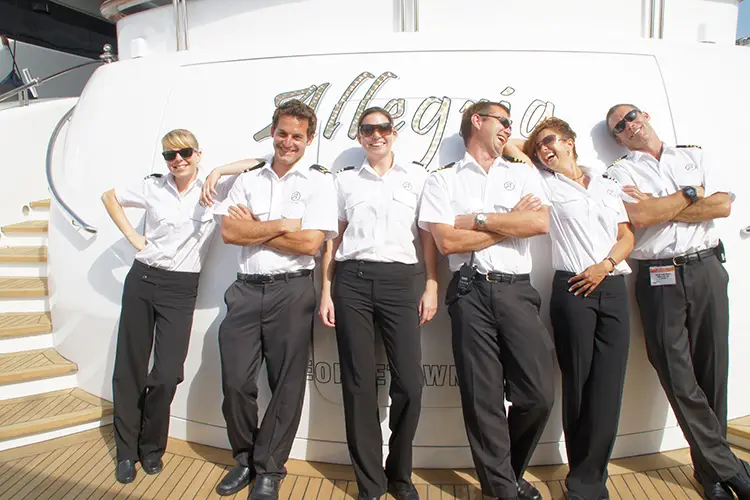
Top 10 Merchant Navy Myths Debunked
Marine careers are often plagued by misconceptions and myths. Merchant navy myths are especially widespread and prevalent. Because of this misinformation, many youngsters get disappointed after joining this merchant navy and quit it. For those in the industry, it is very important to dispel such negative views. The reasons for such disappointments are fake promises…
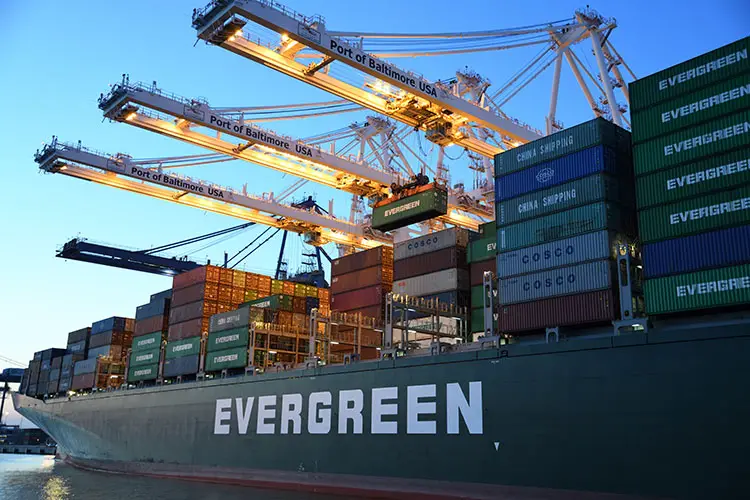
How To Become A Naval Architect?
How To Become A Naval Architect? A Naval Architect is an engineer responsible for the design, construction, and repair of all types of marines vessels like ships, boats, and offshore structures. They are one of the pillars of the shipping industry. Naval architecture involves the planning and designing of ships and other vessels. It is…
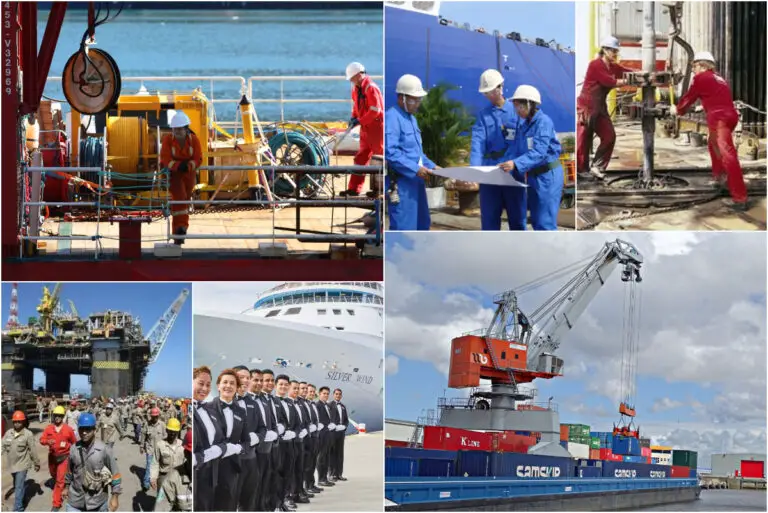
Top Websites For Merchant Navy Jobs
Jobs in the merchant navy are some of the most sought-after jobs. A marine career is not only lucrative but also unconventional and exciting which attracts a lot of aspiring seafarers. The marine industry is a very big industry that constantly needs both skilled and unskilled workers. Even experienced maritime professionals are on a constant…
One Comment
Nice articl Daniel, Ukraine Also on Top Universities For Naval Architecture In World. learn more and update me. cheers
Leave a Reply Cancel reply
Your email address will not be published. Required fields are marked *
Save my name, email, and website in this browser for the next time I comment.
This website uses cookies to improve your experience. We'll assume you're ok with this, but you can opt-out if you wish. Read More

- Subscriptions
Grab a Seat at the Captain’s Table
Essential news coupled with the finest maritime content sourced from across the globe.
Join our crew and become one of the 108,491 members that receive our newsletter.

Dr. Stephen Payne – Designing a Liner, Not a Cruise Ship
Share this article.
Dr. Stephen Payne, OBE, Chief Naval Architect – CUNARD
On the occasion of the Queen Mary 2’s 10th anniversary of her delivery from STX Europe, CUNARD Line’s Chief Naval Architect Dr. Stephen Payne, OBE narrates an inside look at her design and construction.
He notes that although this vessel carries passengers on long ocean voyages in luxury, she is not a cruise ship, but rather a purpose-designed liner capable of criss-crossing across the Atlantic Ocean quickly and safely in all weather conditions.
Kind of makes you want to hop on board and sail across the Atlantic now doesn’t it?
Are you a naval architect? Create a profile on gCaptain’s job board HERE , or browse the latest jobs.
Unlock Exclusive Insights Today!
Join the gCaptain Club for curated content, insider opinions, and vibrant community discussions.
Be the First to Know

Join the 108,491 members that receive our newsletter.
Have a news tip? Let us know.
Stay Ahead with Our Weekly ‘Dispatch’ Email
Dive into a sea of curated content with our weekly ‘Dispatch’ email. Your personal maritime briefing awaits!
Related Articles
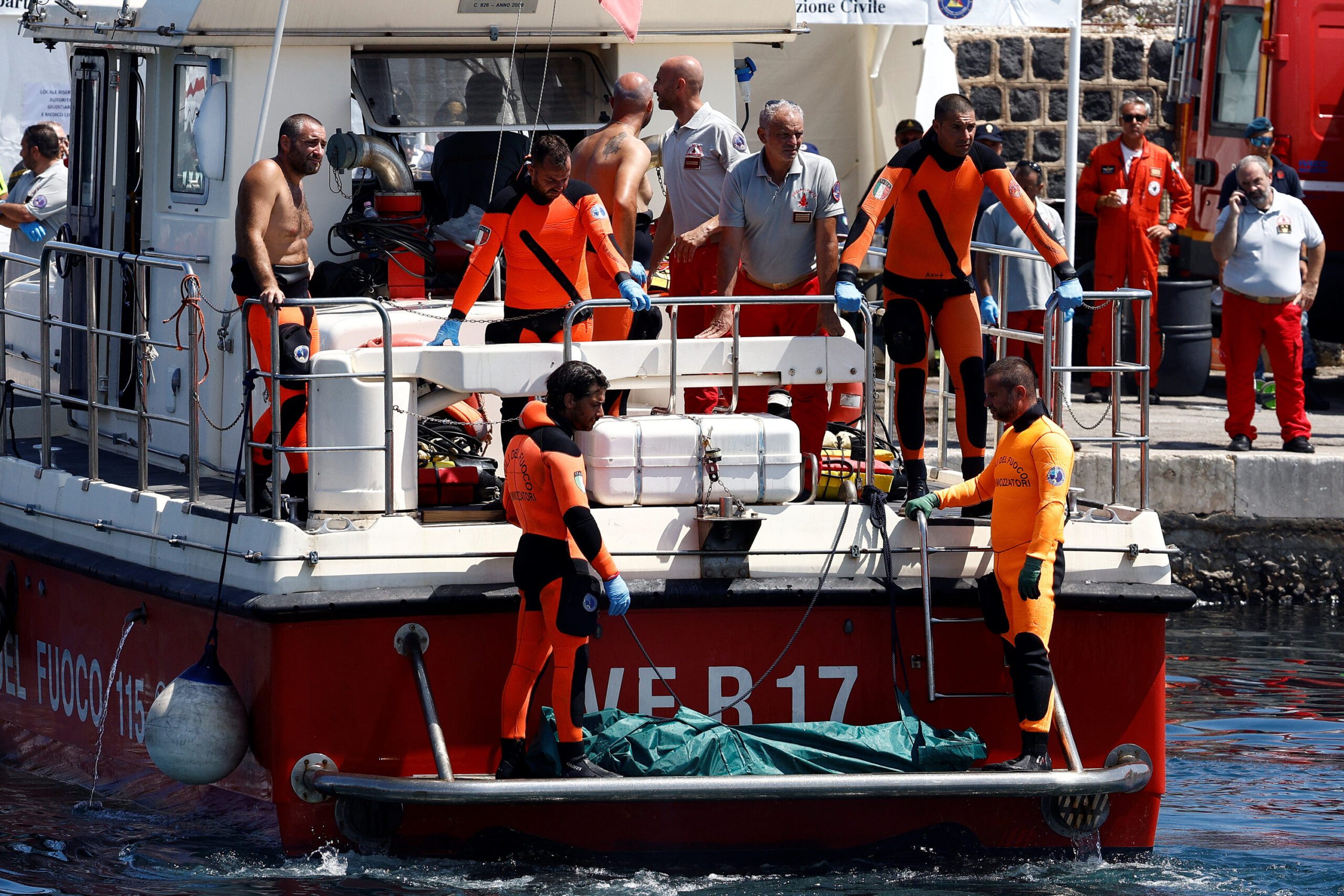
Two More Crew Members From Lynch’s Yacht Under Investigation
PALERMO, Italy, Aug 28 (Reuters) – Italian prosecutors are investigating two more crew members from British tech tycoon Mike Lynch‘s yacht, along with its captain, in connection with the vessel’s sinking over a...
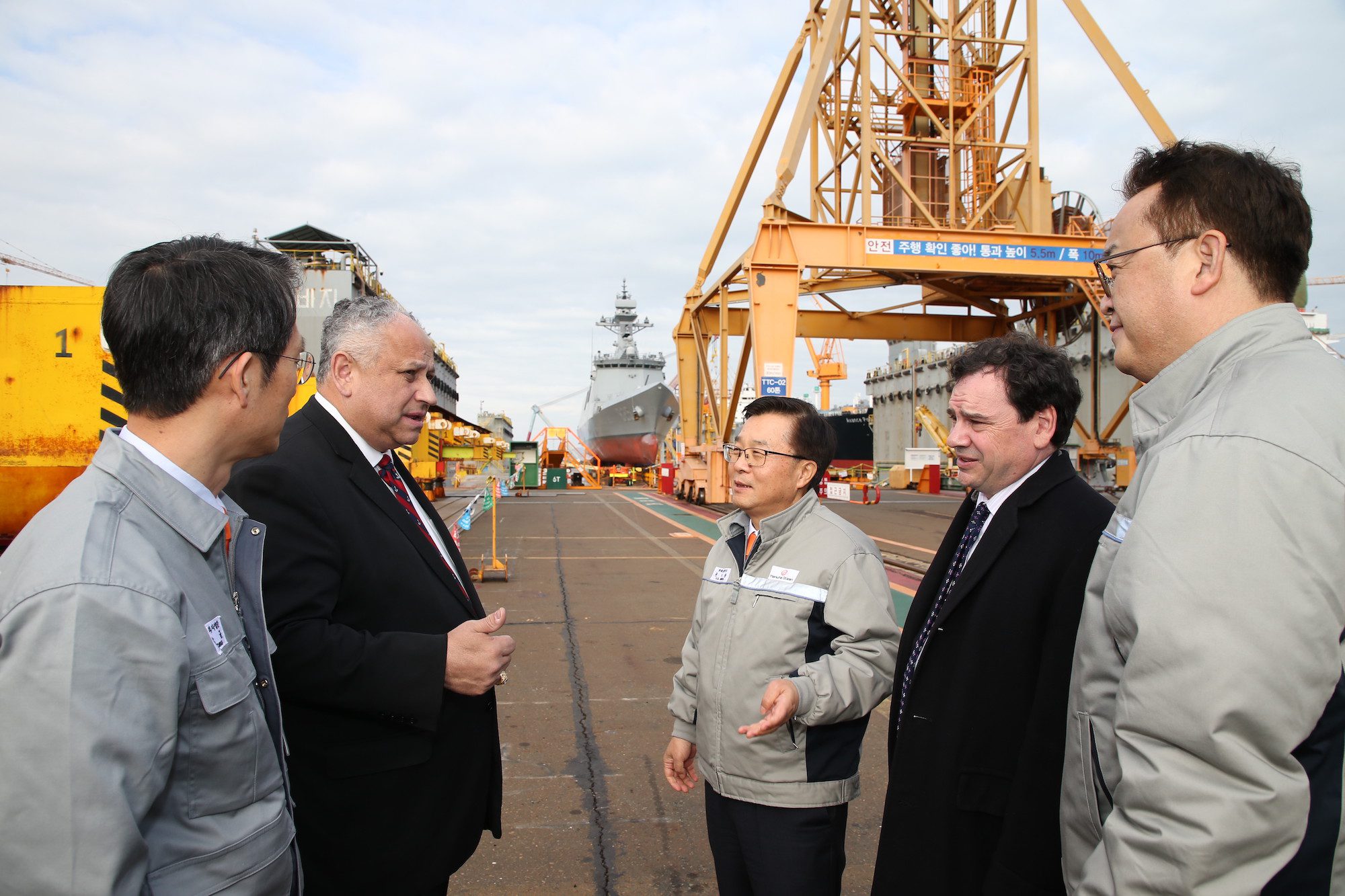
South Korean Shipbuilder Hanwha Ocean Secures Landmark U.S. Navy Maintenance Deal
Hanwha Ocean, the major South Korean shipbuilder, has secured a groundbreaking contract with the U.S. Navy for the maintenance, repair, and overhaul (MRO) of a 40,000-ton logistics support vessel, South...
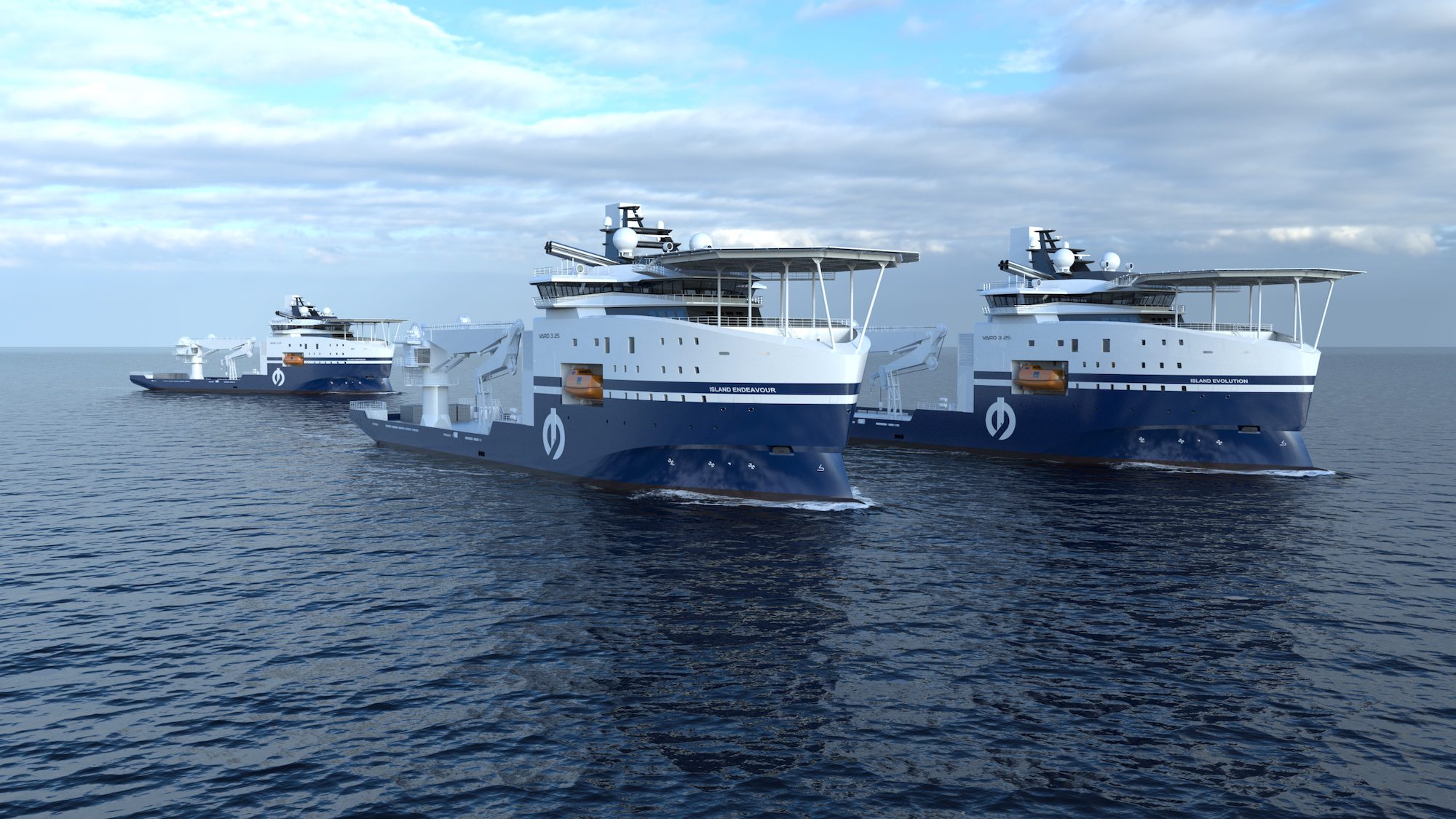
Island Offshore Places Order for Second Hybrid Offshore Energy Construction Vessel
Norwegian shipping group Island Offshore has signed a contract with VARD for the delivery of an additional hybrid power Offshore Energy Construction Vessel (OECV). The new vessel will be a...

Why Join the gCaptain Club?
Access exclusive insights, engage in vibrant discussions, and gain perspectives from our CEO.

OUT AT SEA?
We’ve got you covered with trusted maritime and offshore news from wherever you are.

JOIN OUR CREW
Maritime and offshore news trusted by our 108,491 members delivered daily straight to your inbox.
Your Gateway to the Maritime World!
Join our crew.

Privacy Overview
- How membership works
- Membership Benefits
Medals, Prizes & Awards
Student Ambassador
Scholarships
- RINA Scholarships
- Sir William White Scholarship
- William Froude Scholarship
Branch finder...
Professional Membership
- Associates (AssocRINA)
- Graduate Associate Member (AMRINA)
- Associate Member (AMRINA)
- Member (MRINA)
- Fellow (FRINA)
Membership Fees
Professional Registration
- Registered Professional Engineer Queensland (RPEQ)
Continuing Professional Development (CPD)
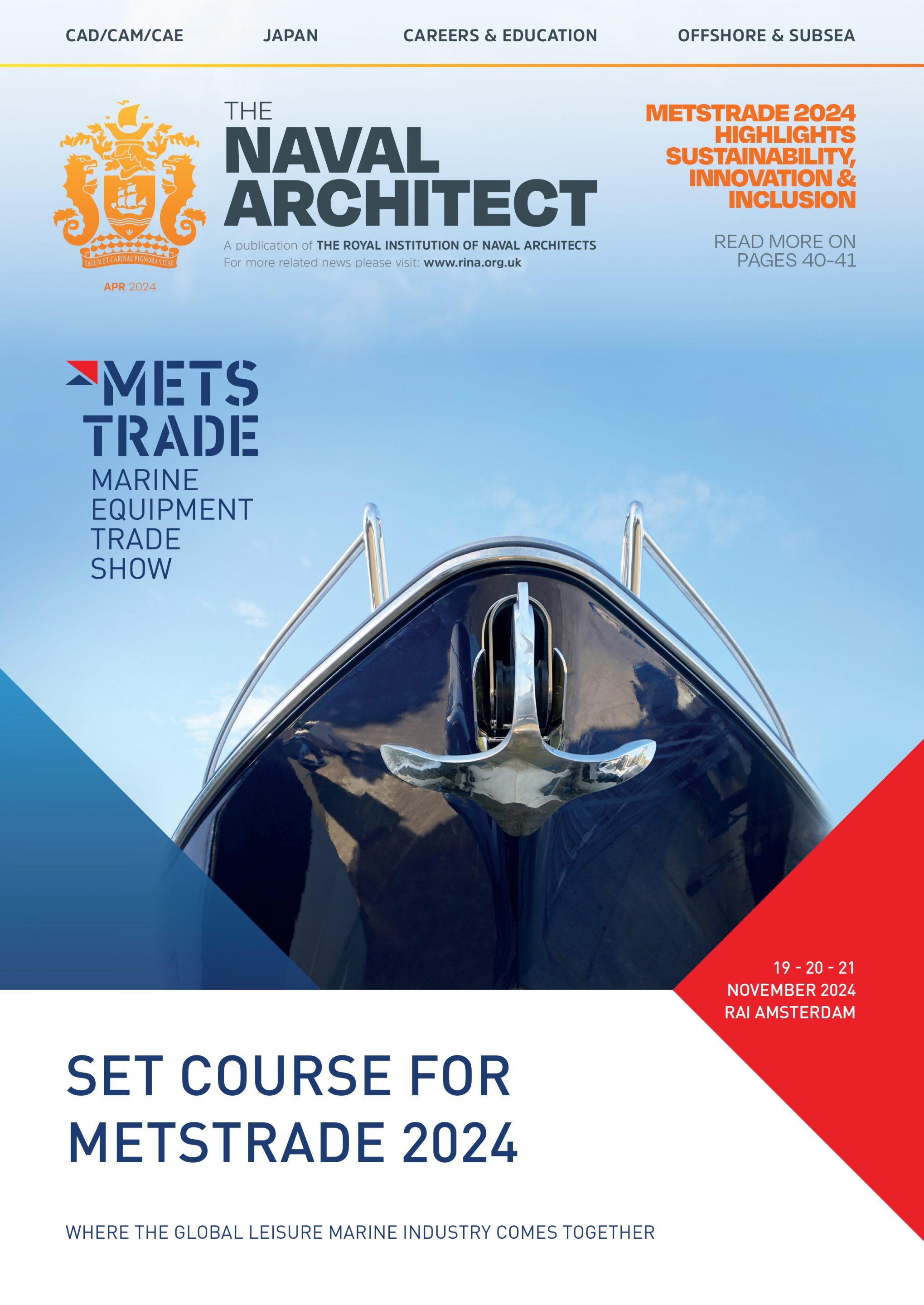
The Naval Architect
Published 10 times per year, The Naval Architect is RINA’s flagship magazine, providing independent, high quality technical information on all aspects of ship design, construction and outfitting of large commercial vessels.
Subscription
Subscription to the Naval Architect is included as a benefit of RINA membership, including five issues per year of our Warship Technology supplement.
All magazines include access to paywalled content on this website related to that publication. For further information please contact our Subscriptions department .

Editor’s Choice

Daniel Johnson
Have a story for our editor get in touch, all articles, editorial schedule.
- Decarbonisation
- LNG & LPG Carriers
- United Kingdom
- Propellers & Thrusters
- Water treatment
- Autonomous Ships
- Cruise Ships
- Shipbuilding technology
- Air lubrication systems
- Chemical & Product Tankers
- CFD & Hydrodynamics
- Careers & Education
- Offshore/heavy Lift
- CAD / CAM /CAE
- Noise & Vibration
- Alternative Fuels
- Ro-ro/Vehicle Carriers
- Paints & Coatings
- Offshore & subsea
- Inland & cosral vessels
- Accommodation & interiors
July/August
- Regulation & Classification
- Bulk Carriers
- Netherlands
- Carbon capture & storage
- Voyage optimisation
- Digitalisation
- Container Ships
- Wind Propulsion
- Multipurpose Vessels
- South Korea
- CAD / CAM / CAE
- Deck & cargo equipment
November/December
- Ship Recycling
- Alternative fuels
- Communication systems
Simply complete the form below to receive two issues of The Naval Architect absolutely free (includes Warship Technology). This is a limited offer, so apply now to make sure you receive your free trial subscription. Members are ineligible for free trial subscriptions.
RINA magazines are available to members & non-members. Digital subscriptions include full access to historical archives.

Royal Navy Ship HMS Trent Seizes Cocaine Worth £40 Million In The Caribbean Sea

Seafarers Hospital Society Launches Pilot Project To Support Women At Sea

Hydrocell Launches The First Hydrogen-Powered Boat

Indian Port Workers Call Off Strike After Agreeing To New Wage Settlement

Understanding Stability of Cruise Ships
How do cruise ships float.
The art of designing vessels to fulfil the design and statutory compliance requirements, stay optimally functional in challenging marine conditions while also being comfortable for the crew, and deliver operational efficiency is a feat of engineering and design in itself when it comes to modern-day cruise ships.
The topic of how cruise ships float has often attracted the attention of curious individuals and budding engineering and design professionals alike.
Picture a cruise ship as a giant floating see-saw for a relatable analogy. It’s designed to stay balanced, so it doesn’t tip over.
Engineers ensure the ship’s weight is evenly distributed and low in the hull. This keeps it steady even when the sea gets rough. The details of how these are practically applied will be looked into in this article.
Why Do Cruise Ships Not Tip Over?
The stability of a cruise ship results from the equilibrium between its weight and the buoyant force acting on it. Cruise ships maintain this equilibrium even in rough seas due to their wide hulls (extended beam) and carefully distributed weight.
In cases where extreme stability is required, naval architects use computer simulations and scaled-down models to ensure the ship can withstand various sea conditions before being run on trials at sea conditions.

From a naval architecture perspective, stability is critical throughout the design and construction phases. Stability is primarily achieved through careful hull design, ensuring the ship’s centre of gravity (G) is as low as possible.
In contrast, the centre of buoyancy (B) remains above G. This arrangement creates a metacentric height, as may be referenced from the image below (GM), which determines the ship’s stability. A positive GM indicates stability, and cruise ships, especially, are designed to have a substantial positive GM owing to the design complexities introduced in them.
Moving on, a few questions and crucial elements speak about cruise ship stability holistically.

Why Do Large Ships Float?
The most familiar picture of a ship has always been the RMS Titanic and the tragic tale surrounding its sinking in 1912. It was the largest vessel built by mankind then, and contemporary ship design and production have progressed and evolved considerably in the past 100 years.
Today, when specifically considering cruise ships, the largest vessel at sea happens to be the Royal Caribbean International’s “The Icon of the Seas”. Speaking of scale and principal particulars, it grosses a tonnage of around 240,000 metric tonnes at 365 meters long, accommodating a mammoth passenger and crew strength of roughly 8,000 people. For reference, the RMS Titanic was about 1/5th of this tonnage and measured around 270 meters in length.
To understand something very foundational to the topic of how cruise ships have gained the capacity to accommodate larger and larger capacity requirements, one needs to understand a major scientific principle that dominates the application in multiple fields of engineering and science, especially fluid mechanics.
The principle of buoyancy, as described by Archimedes, is fundamental to understanding why large ships float. A ship’s hull displaces an amount of water equal to its weight. This displacement generates an upward buoyant force that supports the ship’s weight, keeping it afloat.

Now, focusing on the ship’s hull, as it is commonly questioned how a ball of iron would sink while huge steel ships like these continue to sail and float safely, we come to a key element in hull design—buoyant force optimisation.
The design of a cruise ship’s hull is a precise science. Naval architects consider factors such as hull shape, volume, and weight distribution to optimise buoyancy. The intricate fairing methods and optimisation of the displaced volume ensure optimal volume, form, and function; a factor of safety against rough sea states, hull breach and variational loading conditions play a crucial factor in the iterative method of finalising a hull form for the vessel.
Furthermore, they must ensure the ship’s centre of gravity remains within safe limits to prevent excessive rolling and improve stability. The topic of stability will be discussed next.
Ballast Tanks
Naval architects precisely design ballast tanks within the ship’s framework. By managing the intake and outflow of water into these tanks when sailing, the ship’s stability can be fine-tuned. When a ship faces strong seas or uneven cargo, ballast tanks on one side may be filled to balance the ship and restore stability. This is often managed dynamically by the crew onboard the ship systems.

Aside from stability, something needs attention to be considered in relation to complex forces and loading conditions. We shall discuss how ships manage such conditions using advanced counter-measures based on the same foundational principles governing their floating and stability.
Cruise Ship Rolling and Stabilizers
The rolling of a cruise ship is an important part of seakeeping that directly impacts passenger comfort and safety. The unpredictable nature of ocean travel frequently presents the difficulty of ship rolling , which can cause seasickness and discomfort among passengers and create unsafe stability conditions for the ship at sea.
Cruise ships can still experience rolling due to external forces like waves and wind. To mitigate this, they are equipped with stabilisers, essentially retractable fins or gyroscopes. These devices help counteract the rolling motion by exerting forces in the opposite direction, providing passengers with a smoother and more comfortable ride.
A great deal of focus revolves around the primary systems that deal with these aspects of seakeeping; great stabiliser design ensures that guests can enjoy their cruise experience even in rough sea conditions. Modern advancements in stabiliser systems and dynamic positioning have brought on a new era of safety and control with the benefits of human error reduction and better estimation of the unpredictability of sea loading.
Dynamic positioning systems steer the vessels’ primary and secondary stabilisation mechanisms, often with a fairly intuitive and robust numerical model of the ship and loading conditions on redundant computer systems, which navigates the vessel in tough sea conditions.
A completed vessel goes for extensive sea trials , and these ships especially require thorough examination before being declared fit for sea. A team of 450 specialists worked on these tests for The Icon of the Seas to ensure it meets all the functional requirements while being safe and complying with the norms set for design load lines, classification, and IMO protocols.
Unfortunately, these optimally designed ships do have shortcomings as well. They are often criticised for the environmental impact they create (an average large cruise ship consumes 250 tonnes of fuel each day, emitting various pollutants and greenhouse gases), and some people complain about the overutilisation of space and lack of freedom onboard, although these experiences vary.
In conclusion, the design of large cruise vessels, keeping in mind the required seakeeping performance with optimal manoeuvrability , is a multi-variate problem requiring interdisciplinary sciences such as hydrodynamics, hydrostatics, material science, technological integration, navigation, and positioning technology to come together to produce functional vessels which drive the business of their owners and operators.
You might also like to read-
- Ship Stability – What Makes a Ship Unstable?
- 10 Ways to Achieve Energy Efficiency in Ship’s Electrical System
- Various Methods Used to Minimise Resistance on Ship’s Hull
- Ocean Liners VS Cruise Ships- Everything You Wanted To Know
- What are Polar Cruise Ships?
Disclaimer : The information contained in this website is for general information purposes only. While we endeavour to keep the information up to date and correct, we make no representations or warranties of any kind, express or implied, about the completeness, accuracy, reliability, suitability or availability with respect to the website or the information, products, services, or related graphics contained on the website for any purpose. Any reliance you place on such information is therefore strictly at your own risk.
In no event will we be liable for any loss or damage including without limitation, indirect or consequential loss or damage, or any loss or damage whatsoever arising from loss of data or profits arising out of, or in connection with, the use of this website.

Do you have info to share with us ? Suggest a correction

About Author
Sudripto is pursuing Naval Architecture and Ocean Engineering at IMU, Visakhapatnam, India. He is an aspiring future Naval Architect with an eye for aesthetics and detail and likes to spend his free time writing maritime blogs and reading about maritime innovations which continue to intrigue him. He is also a Senior Editor at Learn Ship Design- A Student Initiative.
Read More Articles By This Author >
Daily Maritime News, Straight To Your Inbox
Sign Up To Get Daily Newsletters
Join over 60k+ people who read our daily newsletters
By subscribing, you agree to our Privacy Policy and may receive occasional deal communications; you can unsubscribe anytime.

BE THE FIRST TO COMMENT
Leave a reply.
Your email address will not be published. Required fields are marked *
Subscribe to Marine Insight Daily Newsletter
" * " indicates required fields
Marine Engineering
Marine Engine Air Compressor Marine Boiler Oily Water Separator Marine Electrical Ship Generator Ship Stabilizer
Nautical Science
Mooring Bridge Watchkeeping Ship Manoeuvring Nautical Charts Anchoring Nautical Equipment Shipboard Guidelines
Explore
Free Maritime eBooks Premium Maritime eBooks Marine Safety Financial Planning Marine Careers Maritime Law Ship Dry Dock
Shipping News Maritime Reports Videos Maritime Piracy Offshore Safety Of Life At Sea (SOLAS) MARPOL

- Engineering & Transportation
- Engineering
Promotions apply when you purchase
These promotions will be applied to this item:
Some promotions may be combined; others are not eligible to be combined with other offers. For details, please see the Terms & Conditions associated with these promotions.
- Highlight, take notes, and search in the book
Rent $27.00
Today through selected date:
Rental price is determined by end date.
Buy for others
Buying and sending ebooks to others.
- Select quantity
- Buy and send eBooks
- Recipients can read on any device
These ebooks can only be redeemed by recipients in the US. Redemption links and eBooks cannot be resold.

Download the free Kindle app and start reading Kindle books instantly on your smartphone, tablet, or computer - no Kindle device required .
Read instantly on your browser with Kindle for Web.
Using your mobile phone camera - scan the code below and download the Kindle app.

Image Unavailable

- To view this video download Flash Player
Follow the author

Cruise Ship Handbook (Springer Series on Naval Architecture, Marine Engineering, Shipbuilding and Shipping 14) Kindle Edition
This book offers a concise, yet comprehensive introduction to the engineering and other principles behind passenger cruise ships. It covers all the important regulations concerning cruise ship design and operation, as well as safety, stability, and environmental aspects. It describes principles of cruise ship hydrodynamics, structures, power plant and propulsion, as well as relevant machinery and control system. Further, it deals with key cruise ship hotel systems, such as air conditioning, freshwater, firefighting, garbage, wastewater and communication systems, and many more. Written in a concise, straightforward style, and including many original drawings, this book offers a unique, informative and inspiring guide, to students and professionals in the field of naval architecture and marine engineering, cruise ship owners and managers, and curious cruise ship passengers alike.
- ISBN-13 978-3031116285
- Sticky notes On Kindle Scribe
- Publisher Springer
- Publication date September 10, 2022
- Language English
- File size 30174 KB
- See all details
Kindle E-Readers
- Kindle Paperwhite
- Kindle Paperwhite (5th Generation)
- Kindle Touch
- Kindle Voyage
- Kindle Oasis
- All new Kindle paperwhite
- All New Kindle E-reader
- Kindle Oasis (9th Generation)
- Kindle Paperwhite (10th Generation)
- Kindle Paperwhite (11th Generation)
- All New Kindle E-reader (11th Generation)
- Kindle Scribe (1st Generation)
- Kindle (10th Generation)
- Kindle Oasis (10th Generation)
Fire Tablets
- Fire HD 8 (8th Generation)
- Fire 7 (9th Generation)
- Fire HD 10 (9th Generation)
- Fire HD 8 (10th Generation)
- Fire HD 10 (11th Generation)
- Fire HD 10 Plus
- Fire 7 (12th Generation)
- Fire HD 8 (12th Generation)
- Fire HD 8 Plus
Free Kindle Reading Apps
- Kindle for Android Phones
- Kindle for Android Tablets
- Kindle for iPhone
- Kindle for iPad
- Kindle for Mac
- Kindle for PC
- Kindle for Web
Editorial Reviews
From the back cover, about the author.
Markus Aarnio is the Chief Naval Architect at Foreship Ltd. in Helsinki. Being employed by a cruise line and naval architect offices, he has worked on hundreds of projects with cruise lines such as Carnival Cruise Line, Norwegian Cruise Line, Royal Caribbean and several others. His experience covers all aspects of cruise ship engineering, from early concepts and specifications to sea trials and delivery, to managing a conversion project. When not working with cruise ships, Markus spends his time in the Finnish archipelago.
Product details
- ASIN : B0BDWHZ7GN
- Publisher : Springer (September 10, 2022)
- Publication date : September 10, 2022
- Language : English
- File size : 30174 KB
- Text-to-Speech : Enabled
- Screen Reader : Supported
- Enhanced typesetting : Enabled
- X-Ray : Not Enabled
- Word Wise : Enabled
- Sticky notes : On Kindle Scribe
- Print length : 317 pages
- #77 in Highway & Traffic Engineering
- #200 in Transportation Engineering (Books)
- #382 in Ships (Kindle Store)
About the author
Markus aarnio.
Discover more of the author’s books, see similar authors, read author blogs and more
Customer reviews
- 5 star 4 star 3 star 2 star 1 star 5 star 100% 0% 0% 0% 0% 100%
- 5 star 4 star 3 star 2 star 1 star 4 star 100% 0% 0% 0% 0% 0%
- 5 star 4 star 3 star 2 star 1 star 3 star 100% 0% 0% 0% 0% 0%
- 5 star 4 star 3 star 2 star 1 star 2 star 100% 0% 0% 0% 0% 0%
- 5 star 4 star 3 star 2 star 1 star 1 star 100% 0% 0% 0% 0% 0%
Customer Reviews, including Product Star Ratings help customers to learn more about the product and decide whether it is the right product for them.
To calculate the overall star rating and percentage breakdown by star, we don’t use a simple average. Instead, our system considers things like how recent a review is and if the reviewer bought the item on Amazon. It also analyzed reviews to verify trustworthiness.
- Sort reviews by Top reviews Most recent Top reviews
Top review from the United States
There was a problem filtering reviews right now. please try again later..
Report an issue
- Amazon Newsletter
- About Amazon
- Accessibility
- Sustainability
- Press Center
- Investor Relations
- Amazon Devices
- Amazon Science
- Sell on Amazon
- Sell apps on Amazon
- Supply to Amazon
- Protect & Build Your Brand
- Become an Affiliate
- Become a Delivery Driver
- Start a Package Delivery Business
- Advertise Your Products
- Self-Publish with Us
- Become an Amazon Hub Partner
- › See More Ways to Make Money
- Amazon Visa
- Amazon Store Card
- Amazon Secured Card
- Amazon Business Card
- Shop with Points
- Credit Card Marketplace
- Reload Your Balance
- Amazon Currency Converter
- Your Account
- Your Orders
- Shipping Rates & Policies
- Amazon Prime
- Returns & Replacements
- Manage Your Content and Devices
- Recalls and Product Safety Alerts
- Registry & Gift List
- Conditions of Use
- Privacy Notice
- Consumer Health Data Privacy Disclosure
- Your Ads Privacy Choices
Naval Architect
Naval Architect: Engineering Consultancy Job Ref: 89/3 Staff Package circa £30k to £35k + Benefits Package
An excellent opportunity has arisen for a Naval Architect to join and work with a team within a leading UK maritime engineering consultancy focusing on expanding its out reach to new and established clients by providing bespoke Marine engineering consultancy.
My client is an established and well regarded entity within its market place and has seen recent rapid growth developing ship and offshore projects and the successful Naval Architect will have an existing work load to work with the high calibre team by supporting them solve high level engineering problems for some of the marine industries leading companies.
Typical work includes but not limited to:
- World Wide travel to visit vessel, clients and shipyard teas
- Structural design and analysis
- Plan approval work
- Project involvement with the full design team and management
- To give practical and technical engineering Guidance
- Supporting the production packages of work to support bids and tenders
You will need to possess
- A background in either Marine Design Consultancy, Shipyards or another relevant ship or offshore design background
- Familiarity and with technical project management of engineering design and/or production
- Educated to a degree level or equivalent
- Ideally with a extensive familiarity of design, conversion and modification marine Projects
- Fluent in professional/technical English
This Naval Architect Opportunity opportunity includes the chance to have input in the new growth of an expanding company during an exciting period of company growth along with national and international travel.
This position is based in Glasgow.
This vacancy is being advertised by WRS Tech Ltd.
Cruise Ship Jobs
- Housekeeping Jobs (82)
- Galley Jobs (267)
- Restaurant Jobs (101)
- Beverages Jobs (75)
- Provisions Jobs (12)
- Deck Jobs (101)
- Engine / Technical Jobs (128)
- Guest Services Jobs (103)
- Retail Jobs (51)
- Spa & Beauty Jobs (45)
- Child Care Jobs (17)
- Entertainment Jobs (134)
- Photography Jobs (16)
- Shore Excursions Jobs (30)
- Medical Jobs (14)
- Sport & Fitness Jobs (16)
- Casino Jobs (19)
- IT Jobs (8)
- Management Jobs (53)
- Administration Jobs (47)
- Land Based Jobs (26)
- Other Cruise Jobs (72)
- Private Estate Jobs (5)
Find jobs by department
CV Writing Service
Have your CV written by a professional CV Writer who specialises in writing CVs for candidates looking for cruise ship jobs.
Email address:
Remember me Forgotten password?
Password Reset
Enter your email address and we will email you a password reset link.
Share this page:
The Navy’s Newest Submarine Is Finally Here—and It’s Still No Match for China
The USS Idaho joins a vital—but painfully slow-growing—sub fleet .

- The USS Idaho , the U.S. Navy’s latest Virginia- class attack submarine, officially launched last week after taking seven years to build.
- The Navy is going to need more submarines to rival China’s naval buildup but won’t get the number it needs for nearly 30 years.
- The ideal number of attack subs is 66, but Naval production is only on track to get to 48 by 2030 and 56 by 2040.
New Kid on the Block

The submarine, P.C.U. Idaho , is the 26th Virginia -class nuclear-powered attack submarine. The sub, which was built by Electric Boat and Newport News Shipbuilding and took seven years to complete, was christened in March 2024 in Groton, Connecticut, after its construction was lengthened by COVID-19 and supply chain disruptions. Per tradition, the ship is temporarily designated P.C.U., or Pre-Commissioning Unit. The ship takes on the USS. designation, or United States Ship, once it is commissioned and handed over to the fleet.
Idaho is 377 feet long with a beam (width) of 34 feet. It displaces 7,900 tons underwater, three times more than its ancestor, a World War II Gato -class submarine. A single S9G (the G stands for General Electric) nuclear reactor drives a pump-jet propulsor instead of a traditional propeller screw, enabling the sub to reach a top speed of 25 knots. Like all nuclear-powered ships it has virtually unlimited range, its endurance limited only by the ship’s food supplies for the 135-person crew. Each has four 533 mm torpedo tubes, the standard torpedo diameter since well before World War II, enabling it to fire Mk. 48 ADCAP heavyweight torpedoes and sub-harpoon anti-ship cruise missiles.

The Navy has slowly improved the Virginia class over time in a series of blocks, a cost-saving measure over building a completely new boat that started with Block I. Idaho is what is referred to as a Block IV boat. One improvement introduced with the Block III boats is the swapping of twelve individual vertical launch silos, each of which could carry one Tomahawk cruise missile, with two 87-inch diameter Virginia Payload Tubes, each of which can carry six Tomahawk missiles. According to the Navy , the tubes are designed to “simplify construction, reduce acquisition costs, and provide for more payload flexibility than the smaller VLS tubes due to their added volume”
Idaho will remain pierside as shipyard workers install necessary equipment. According to the USS Idaho Commissioning Committee , she is due to be commissioned into the fleet in Spring 2025.
Preparing for War

Idaho enters the fleet as the U.S. submarine force is about to ungergo major changes. Submarines are viewed as a major fleet asset in a potential war with China, capable of crossing the Pacific quickly and taking up station in the Western Pacific. At least one submarine is thought to be in the Philippine Sea at all times. Today U.S. Pacific Fleet submarines are based in Guam, Washington State, and Hawaii. Under the new Australia-United Kingdom-United States (AUKUS) agreement, U.S. submarines will operate out of Australia by 2027 , vastly decreasing the time needed to reach “WestPac” in a crisis.
In the meantime, the U.S. is attempting to grow the submarine fleet as a counter to China’s growing navy. Although China’s own naval fleet is growing fast, it has no practical experience in anti-submarine warfare, and its submarines are easily a generation, if not two, behind American subs. Coupled with a submarine’s ability to stalk and ambush surface ships, Navy planners believe that America’s fleet of Los Angeles , Seawolf , and Virginia -class submarines will punch above their weight in a conflict with China, but there is still a consensus that the fleet must grow—fast.

Unfortunately, while the submarine fleet will grow, it won’t happen fast. By 2030, the Navy anticipates having 48 attack submarines and 12 ballistic missile submarines on hand. By 2040, the Navy will have 56 attack subs and 13 ballistic missile subs. According to the latest projections, Navy won’t reach its goal of 66 attack subs until 2054, thirty years from now.
Why is the fleet growing so slow? A smaller defense budget is one reason: defense spending accounts for only 2.7 percent of the GDP , the lowest since 1999, compared to 5.7 percent in 1985, at the height of the Cold War, and 8.6 percent during the Vietnam War. Other factors include a withered industrial base, with fewer shipyards and thus fewer facilities to build submarines, as well as fewer trained workers. American shipyards are also building three Virginia s for the Royal Australian Navy, which, although the work will detract from the Navy’s total, the subs will still go to a fleet strongly allied with the United States—and against China.
Changes Full Steam Ahead

One of the biggest changes to the submarine fleet is the upcoming replacement of the 14 Ohio -class ballistic missile submarines, each of which carries up to 20 Trident II D-5 nuclear-tipped missiles, with 12 new Columbia- class boats, each with 16 Trident II missiles. The first Columbia -class boat, the USS District of Columbia , is expected to be complete by 2027 and begin its first nuclear deterrence patrol in 2031. As more Columbia s enter the fleet, the Ohio s will retire, with the last Columbia expected to be completed by 2041. There is some question, however, whether 12 submarines will be able to deter both Russia and China, the latter of which is embarking on a major nuclear buildup .
In the early 2000s, four submarines, Ohio , Michigan , Florida , and Georgia (collectively, OMFG ) were declared redundant as a result of the Strategic Arms Reduction Talks (START) II treaty with Russia. Rather than retire the ships, the Navy instead chose to convert them to guided-missile submarines. Each can carry a staggering 154 Tomahawk cruise missiles, giving each more short-term firepower than an aircraft carrier. As useful as they are, the subs are at the end of their service lives and all four will retire by 2028. Once the Columbia production run is finished, the Navy will order four new guided-missile subs, likely based on the Columbia hull, entering service in 2045.

As for attack submarines, the Navy plans to continue building Virginia -class submarines for several more decades, keeping up the steady pattern of upgrades to keep them on the cutting edge. After two more Block IV submarines, the service will receive its first Block V sub. The Block Vs will be 70 feet longer, to accommodate payload modules designed to carry up to 28 Tomahawk cruise missiles, for a total ship load-out of 40 Tomahawks per boat. The Block Vs will also be able to carry the Navy’s new Conventional Prompt Strike hypersonic missiles instead of Tomahawks. A Block VI class is anticipated but its feature set is to be determined.
A replacement for the Virginia class, SSN(X) , is projected to enter service in 2041.
The Navy’s submarine fleet might well be the most important factor deterring China, Russia, and other like-minded nations from starting a war. As America’s submarine force grows, the options available to its adversaries shrinks, until the option of victory becomes vanishingly small. Building this fleet is no longer an industrial enterprise, it’s a geopolitical race that the Navy—and America—can’t afford to lose.

Kyle Mizokami is a writer on defense and security issues and has been at Popular Mechanics since 2015. If it involves explosions or projectiles, he's generally in favor of it. Kyle’s articles have appeared at The Daily Beast, U.S. Naval Institute News, The Diplomat, Foreign Policy, Combat Aircraft Monthly, VICE News , and others. He lives in San Francisco.

.css-cuqpxl:before{padding-right:0.3125rem;content:'//';display:inline;} Pop Mech Pro .css-xtujxj:before{padding-left:0.3125rem;content:'//';display:inline;}
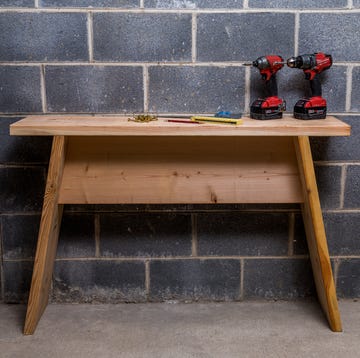
We’re Plugging Into the World’s Biggest Battery
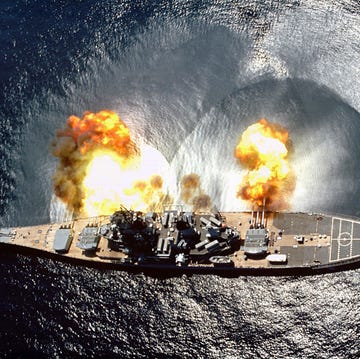
We Could Bring Back the Iowa-Class Battleships

The U.S. Government Set ‘Traps’ to Catch UFOs

Do Psychedelics Reveal an ‘Ultimate Reality?’

How We Defeat Mosquitoes When Working Outdoors

The Day Russia's Supersonic Jet Fell From the Sky

Russian Flaunts Nuclear-Tipped Air-to-Air Missile

Chinese Missile Tech Finally Caught Up To The U.S.

China's H-6 Bomber To Play Vital Role in Air Force

The Space Force is Calling for “Fires” in Space

Did This Man Solve the Amelia Earhart Mystery?
- - K-town Now
- Asia-Pacific
- - Storm Tracker
- Middle East
- Map of Memorials
- Entertainment
- - Video Games
- Europe Travel
- - Quick Trips
- - After Hours
- Pacific Travel
- The Meat and Potatoes of Life
- U.S. Travel
- Storm Tracker
- Rewards for readers
- Get Stripes
- Stripes Lite
- Archives/Library
- Special Publications
- Mobile Apps
- Email Newsletters
- Digital Access
- Home Delivery
- Marine Corps
- Coast Guard
- Space Force
- Archive photo of the day
- - Schedules Europe
- - Scoreboards Europe
- - Schedules Pacific
- - Scoreboards Pacific
- - Pacific Sports Blog
- - WW II Podcast
- - Military Matters
- - Force for Hire
- Out of Uniform
- - WW II Videos
- Communities
- Stripes Europe
- Stripes Guam
- Stripes Japan
- Stripes Korea
- Stripes Okinawa
- Our Other Websites
- In Memoriam
- Month of the Military Child
- Best of Germany
- Best of the Pacific
- Letters to Santa
USS Cowpens, a ship that helped establish the Tomahawk as a feared weapon, decommissioned in San Diego
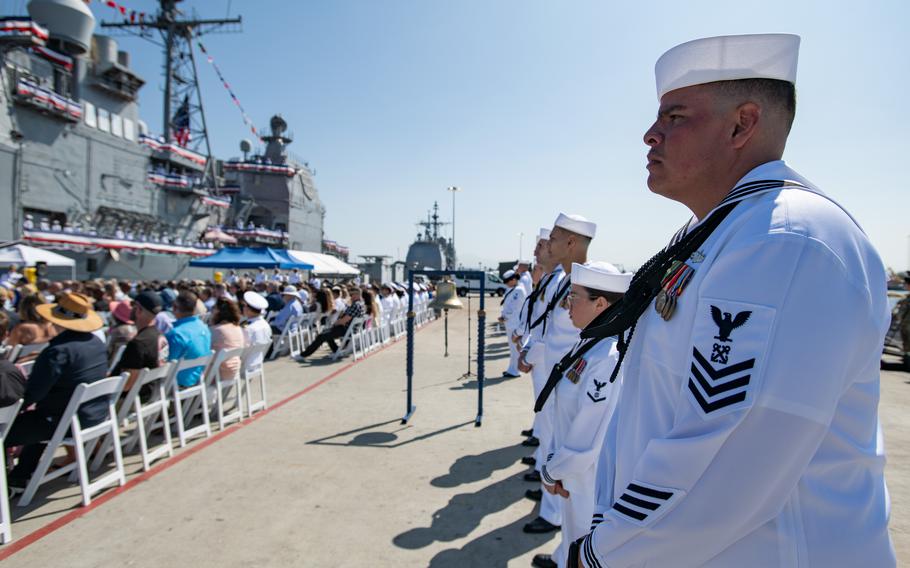
Sailors assigned to the Ticonderoga-class guided-missile cruiser USS Cowpens (CG 63) participate in the ship’s decommissioning ceremony at Naval Base San Diego on Aug. 27, 2024. (Claire M. DuBois/U.S. Navy)
Ticonderoga-class guided-missile cruiser USS Cowpens (CG 63), a ship that helped establish the Tomahawk cruise missile as one of the military’s most feared weapons, was retired Tuesday at Naval Base San Diego .
Hundreds gathered at the decommissioning to celebrate the ship’s 33 years of service.
“A guiding principle in the last chapter onboard, has been to honor the legacy of Cowpens,” said Cmdr. Jac O. Ullman III, the ship’s commanding officer.
The move is part of an effort to decommission all remaining Ticonderoga-class guided-missile cruisers before the end of the decade. The Navy built 27 of the ships from 1980 through 1994 to counter the Soviet Union during the Cold War. Thirteen are still in service. The class is being replaced by Arleigh Burke-class destroyers.
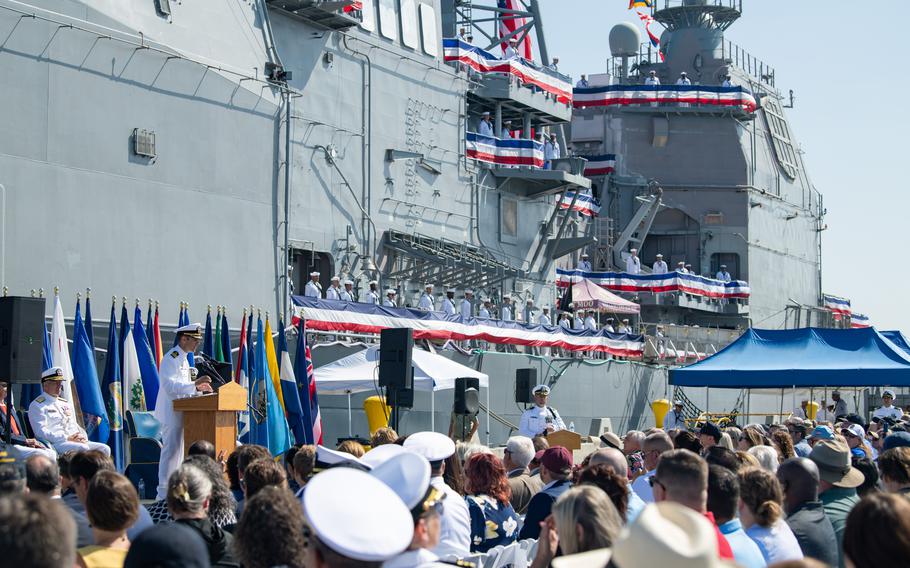
Cmdr. Jac Ullman III, commanding officer of the Ticonderoga-class guided-missile cruiser USS Cowpens (CG 63), delivers opening remarks at the ship’s decommissioning ceremony at Naval Base San Diego on Aug. 27, 2024. (Claire M. DuBois/U.S. Navy)
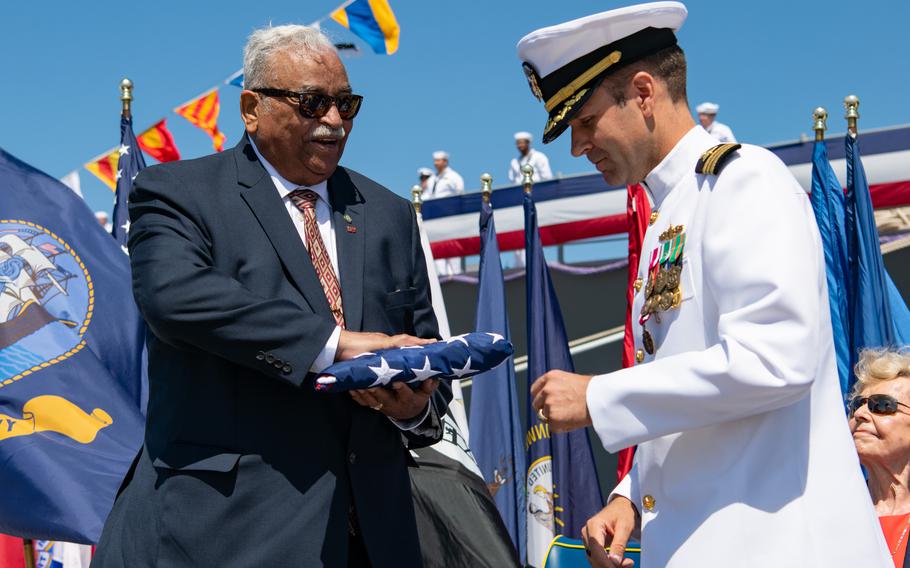
Cmdr. Jac O. Ullman III, commanding officer of the Ticonderoga-class guided-missile cruiser USS Cowpens (CG 63), right, presents an American Flag representing the ship’s Ensign to retired Vice Adm. Edward Moore during the ship’s decommissioning ceremony at Naval Base San Diego on Aug. 27, 2024. (Claire M. DuBois/U.S. Navy)
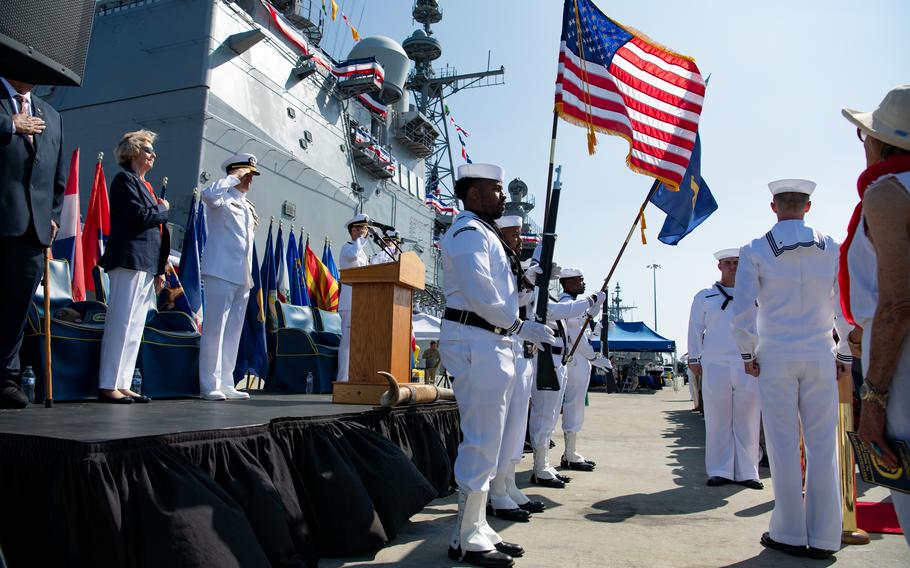
Sailors and guests render honors to the national Ensign at the decommissioning ceremony for the Ticonderoga-class guided-missile cruiser USS Cowpens (CG 63) at Naval Base San Diego on Aug. 27, 2024. (Claire M. DuBois/U.S. Navy)
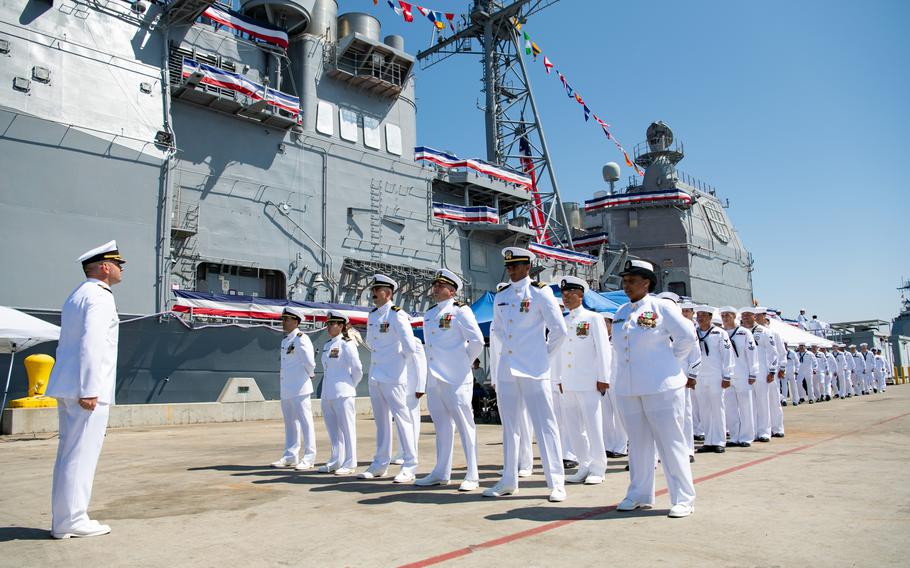
Cmdr. Timothy Barry, executive officer of the Ticonderoga-class guided-missile cruiser USS Cowpens (CG 63), left, watches as its crew leaves the ship during its decommissioning ceremony at Naval Base San Diego on Aug. 27, 2024. (Claire M. DuBois/U.S. Navy)
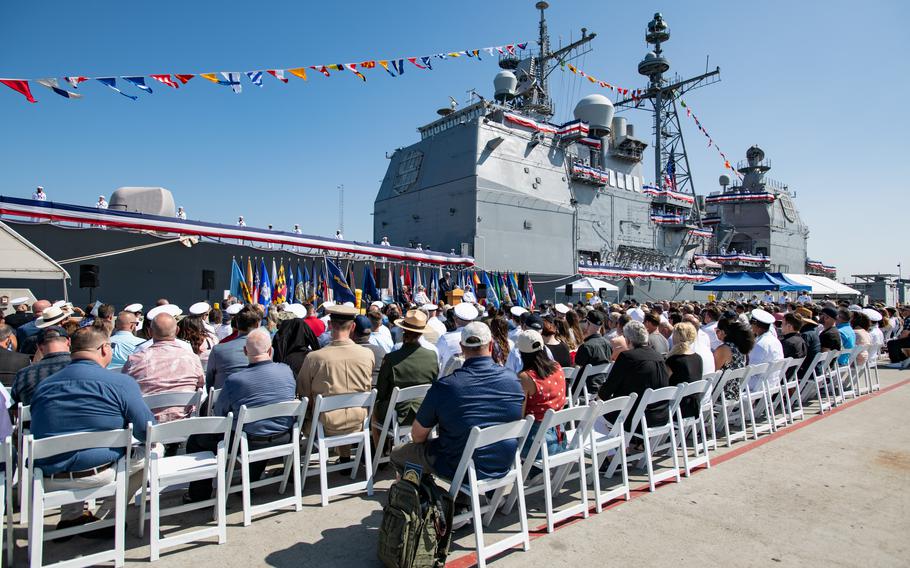
Retired Vice Adm. Edward Moore delivers remarks at the decommissioning ceremony for the Ticonderoga-class guided-missile cruiser USS Cowpens (CG 63) at Naval Base San Diego on Aug. 27, 2024. (Claire M. DuBois/U.S. Navy)
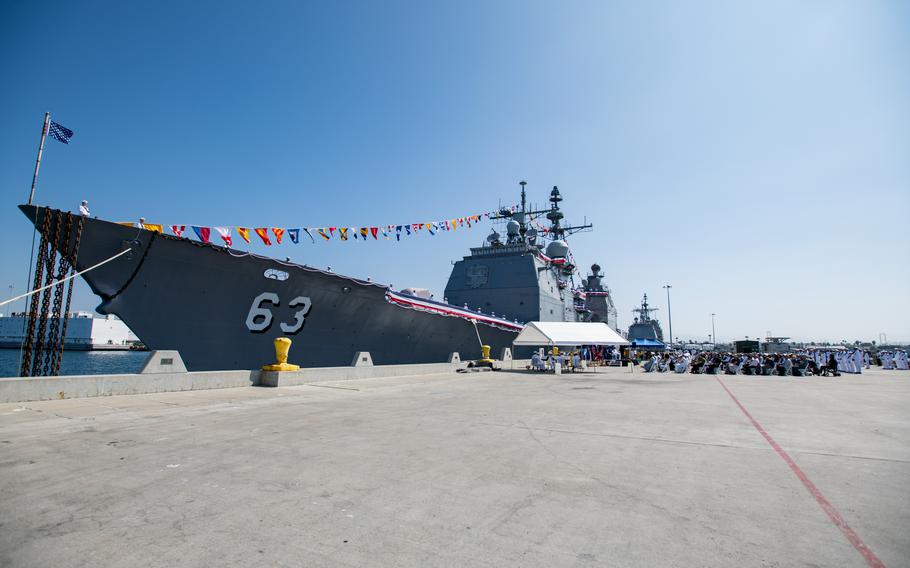
The Cowpens was launched in March 1989 in Charleston, S.C. It is the second warship to be named after the Battle of Cowpens, a Revolutionary War battle in which colonial soldiers defeated British troops near Chesnee, S.C. Historians say the fight occurred close to pastures known as cow pens.
The latter warship is affectionately known as the Mighty Moo and its crews as the Thundering Herd.
“To honor the grit, determination, and creativity of the Continental Army and militiamen from that cold battlefield,” Ullman said. “To honor the service of those on the first USS Cowpens — CVL 25 — and to honor the legacy of those who served before us during Mighty Moo’s 33-year career. … We have done just that.”
The Cowpens was commissioned in March 1991. Less that two years later, the ship fired 10 Tomahawk cruise missiles into Iraq , which had violated no-fly zone sanctions in the region. The volley was part of a major strike by coalition forces. In March 2003, as part of the USS Kitty Hawk battle group, it was the first warship to launch Tomahawk missiles into Iraq, marking the start of Operation Iraqi Freedom — the campaign that brought down Saddam Hussein.
USS Cowpens participated in many operations and exercises, contributing significantly to U.S. naval power projection and security. From enforcing no-fly zones to conducting maritime security operations, the ship demonstrated versatility and capability across a range of mission profiles.
Contributing: The San Diego Union-Tribune (TNS).

USS Cowpens (CG 63), foreground, is followed by USS Lassen (DDG 82), USS John S. McCain (DDG 56), USS Vandegrift (FFG 48) and USNS Tippecanoe (T-AO 199) during a photo exercise to kick off Exercise Valiant Shield 2006 in the Pacific Ocean on Sunday June 18, 2006. (U.S. Navy)
USS Cowpens sailors stand watch in front of the vertical launching system in March 2003. (Kendra Helmer/Stars and Stripes)

Ensign George Bick, 25, gives a thumbs-up from the helicopter control tower on the USS Cowpens as a helicopter makes a brief stop on the guided missile cruiser in the northern Persian Gulf in March 2003. (Kendra Helmer/Stars and Stripes)
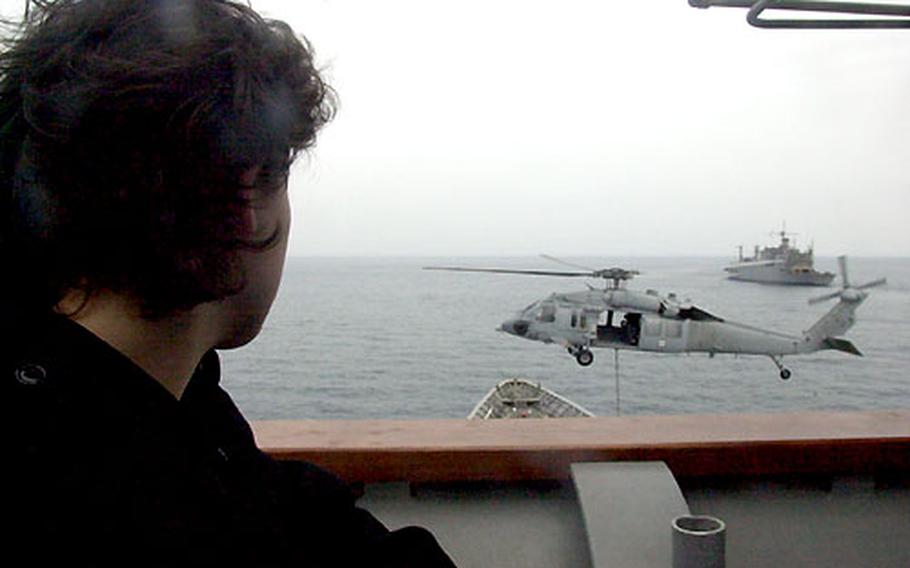
From the bridge of the USS Cowpens, Ensign Rebecca Farley, an engineering training officer, watches a helicopter drop off ammunition from the USNS Flint (background) in March 2003. (Kendra Helmer/Stars and Stripes)

Sailors of the USS Cowpens wave as they return to Yokosuka Naval Base in May 2003. The USS returned Tuesday with the USS Kitty Hawk and USS John S. McCain from their deployment to the Persian Gulf. (Jim Schulz/Stars and Stripes)
related stories
- USS Antietam arrives at new homeport in Hawaii
- USS Bunker Hill, one of the Navy’s last Cold War-era cruisers, is decommissioned in San Diego
Sign Up for Daily Headlines
Sign up to receive a daily email of today's top military news stories from Stars and Stripes and top news outlets from around the world.
Sign Up Now
Switch language:

The Type 83: a Royal Navy air defence cruiser for a new age
The Royal Navy’s next-generation air defence platform could be a 10,000 tonne, 180 metre-long Ticonderoga-esque behemoth, or perhaps similar to the in-service Type 45 class.
- Share on Linkedin
- Share on Facebook
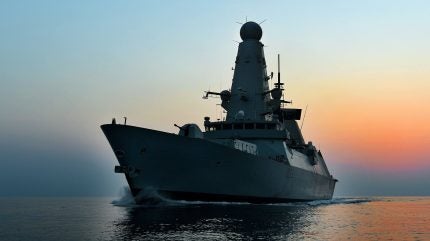
The UK’s planned Type 83 warship programme will develop a next-generation air defence platform for the Royal Navy, replacing the existing Type 45 class and introducing a range of new capabilities with a vessel likely to include ballistic and hypersonic missile defence and laser directed-energy (LDEW) weapons.
Free Buyers Guide
Leading guide to warship design, build, modernisation and repair solutions for the naval industry, go deeper with globaldata.

Naval Vessels and Surface Combatants Market Size, Share, Trend and ...
Data insights.
The gold standard of business intelligence.
Find out more
Related Company Profiles
Bae systems plc, bae systems inc, rolls-royce holdings plc, mbda holdings sas, kongsberg gruppen asa.
Your download email will arrive shortly.Please check your mail inbox to download buyer's guide
You may also be interested in:
By downloading this case study, you acknowledge that GlobalData UK Limited may share your information with our white paper partners/sponsors who may contact you directly with information on their products and services.
Tick here to opt out of curated industry news, reports, and event updates
How well do you really know your competitors?
Access the most comprehensive Company Profiles on the market, powered by GlobalData. Save hours of research. Gain competitive edge.

Your download email will arrive shortly
Not ready to buy yet? Download a free sample
We are confident about the unique quality of our Company Profiles. However, we want you to make the most beneficial decision for your business, so we offer a free sample that you can download by submitting the below form
Visit our Privacy Policy for more information about our services, how GlobalData may use, process and share your personal data, including information on your rights in respect of your personal data and how you can unsubscribe from future marketing communications. Our services are intended for corporate subscribers and you warrant that the email address submitted is your corporate email address.
It will be at the heart of the Future Air Dominance System (FADS) programme, currently in its pre-concept phase, that will network a range of systems to create an air defence umbrella under which UK military can operate.
The previous UK Conservative government said earlier this year that the under current plans the first-of-class Type 83 air defence destroyer, which will replace the in-service Type 45 destroyer class (above), will enter service in the late 2030s.
The new Labour government has initiated a new Strategic Defence Review to determine whether any changes to the country’s defence modernisation programmes need to be made, but it is unlikely to derail the Type 83 programme .
How many Type 83 vessels will there be?
The UK has for decades replaced more numerous platforms with fewer, more capable systems, a process of ‘gold-plating’ that theoretically provides exquisite capability, but with virtually no strength in depth.
In the UK’s Defence in a Competitive Age document, published in March 2021, mentions of a Type 83 platform that would replace the Type 45 air defence destroyer proliferated under a ‘2030 vision’ that would have a “shipbuilding enterprise at the forefront of technological and environmental innovations”.
With the UK Ministry of Defence (MoD), or ‘Defence’ in the document, “committed to playing a leading role across government” in support of a national shipbuilding sector plan, programmes such as the nascent Type 83 would be particularly significant.
The document called for a “concept and assessment phase for our new Type 83 destroyer” which would begin to replace the 7,500 tonne-Type 45s from the late 2030s.
According to data from the previous UK government released in January 2024, the final Type 45 destroyer would leave service by the end of 2038, meaning the Royal Navy could see its air defence capability dwindle as earlier Type 45s are decommissioned ahead of the early-build Type 83s.
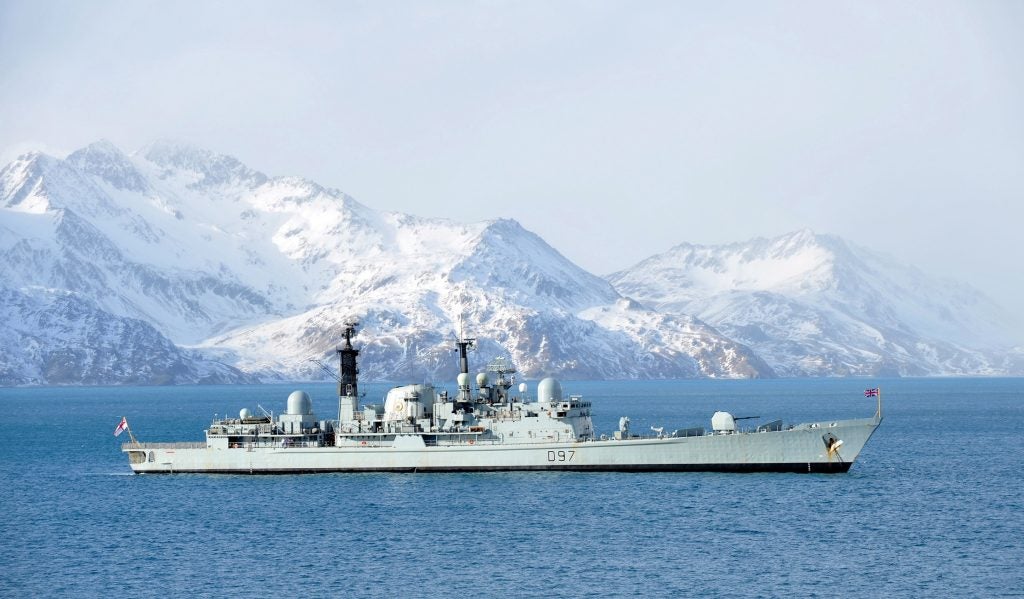
A total of six Type 45 destroyers were built, but this itself was reduced from 12 originally planned, with the class replacing the Falkland’s War era Type 42 destroyers (above), which numbered 14 hulls at full strength.
The Type 42s themselves were an attempt to produce an air defence-centric surface combatant, following the cancellation of the previous Type 82 programme, that saw just a single vessel ( HMS Bristol ) completed out of planned eight in class. The Type 82s were planned to replace the 1960s era County-class destroyers, designs which, while featuring missile-based anti-aircraft systems, stuck to multi-role roots with two, twin barrelled main guns mounted forward.
Keeping to the modern era, the Royal Navy has seen its air warfare destroyer force reduce, with the prospect that Type 83 fleet could dip further, perhaps to three or four hulls. However, in order to accommodate an expected wide range of weapons and required power generation, the Type 83 class could displace up to 10,000 tonnes each, perhaps reaching a length of 170-180 metres (m), compared to the Type 45 length of 152m.
What weapons could it feature?
A possible weapons outfitting for a future Type 83 destroyer is hypothetical at the pre-concept stage the programme is in, however it is possible to look at current and near future term capabilities that could be adopted to the class.
It is likely that the Type 83 will incorporate full length Mk 41 vertical launch systems (VLS) from the US, a capability being incorporated into the upcoming Type 31 and Type 26 frigates due to enter service this decade. The Mk 41 VLS is able to accommodate a range of short, medium, and long-range surface-to-air missiles, such as Raytheon’s SM-3 and SM-6.
The total number of Mk 41 launch cells that the Type 83 could feature is of course unknown, but in 2023 the Type 45 were confirmed to receive a planned 50% increase in missile capacity with the addition of a 24-cell Sea Ceptor farm, installed behind the 48-cell Sea Viper anti-air system. The Type 45 class use the French-origin A50 Sylver VLS, incorporating a mix of up to 48 short-range Aster 15 missiles for targets up to 30km away, and Aster 30 missiles for targets out to 120km.
The large Ticonderoga -class guided missile cruisers operated by the US Navy point to what kind of loadout a Type 83 of similar size could have, with the Tico’s featuring 122 Mk 41 launch cells.
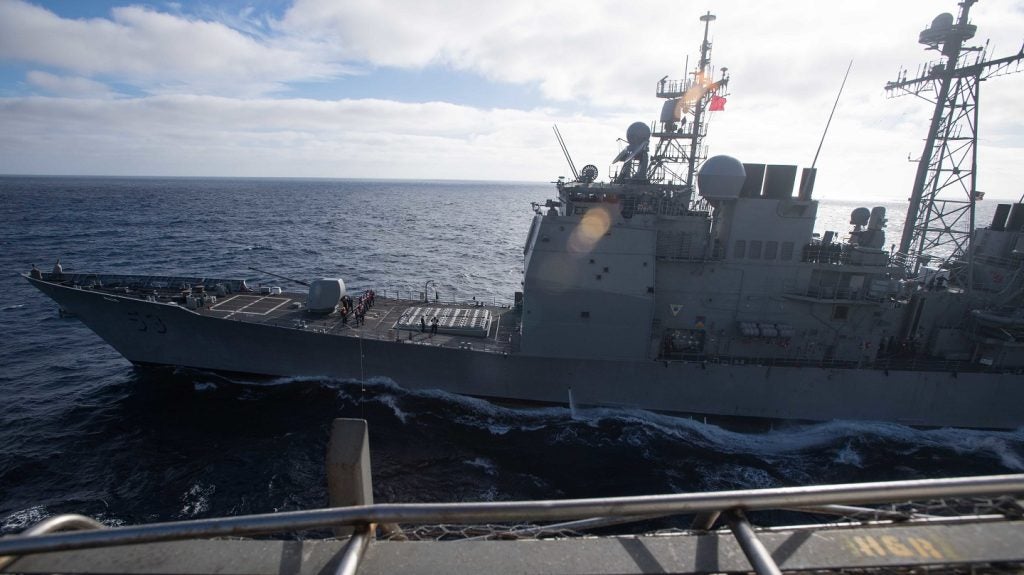
In addition, Maritime Strike, or Block Vb, Tomahawk cruise missile will also be able to be fired from the Mk 41, providing a capable anti-surface warfare capability, or the joint UK-French Future Cruise Anti-Ship Warfare cruise missile, derived from MBDA’s Storm Shadow/SCALP system.
However, additional anti-surface munitions could be required, so it is likely that the Type 83 may also feature canister-launched missiles such as the Naval Strike Missile from Kongsberg .
It is almost certain that the Type 83 will also take advantage of directed energy weapons systems, such as the DragonFire high energy laser currently being developed by the UK, with trials of the platform expected to begin in the naval domain by 2027 .

In terms of naval gunfire support, every main surface combatant of the Royal Navy has featured a main gun system, since the Ikara and Exocet variants of the Leander frigate in the 1960s. Given this, a main gun system such as the BAE Systems Mark 45, 5 inch 62-calibre weapons could be equipped.
Due to the increased threat of small and medium sized-drones and proliferation of anti-ship missiles into countries such as Yemen, it is also likely that the Type 83 will equip additional secondary weapons systems, including perhaps the 40mm Bofors being fitted to the Type 31 frigates, offering cost-effective target engagement.
The Type 83s will also certainly feature Phalanx CIWS, and numerous small arms from 7.62mm up to .50 calibre machine guns,
What sensors and propulsion could the Type 83 have?
Similar to determining any prospective weapons loadouts, pointing with complete certainty to sensor or propulsion equipment is still at best an estimation. However, a BAE Systems funded study, to be conducted by Reaction Engines , into exhaust heat reduction and capture possible suggests the future Type 83 could be a stealth design, or certainly incorporating increased stealth features.
The Type 83 will be conventionally propelled, with nuclear power being kept only for the Royal Navy hunter-killer and ballistic missile submarines. Rolls Royce ’s MT30 gas turbines would be a strong option, coupled with MTU diesel engines, in a similar combined diesel-electric and gas (CODLAG) configuration being introduced into the Type 26 anti-submarine frigates.
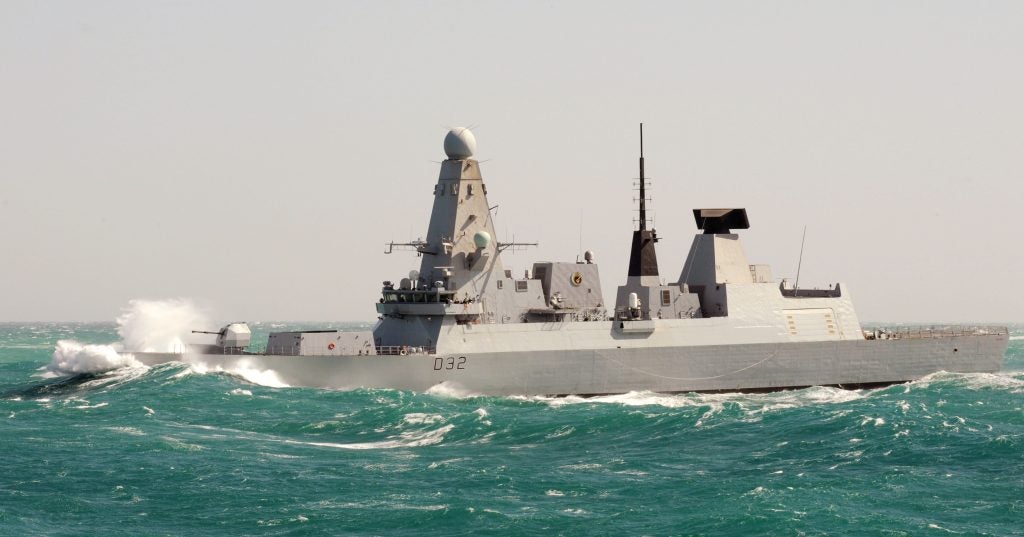
Such propulsion may or may not be rafted in order to reduce acoustic noise, as the class will not be operated as anti-submarine warfare platforms, and likely used mainly in conjunction with the periodic Queen Elizabeth -class carrier strike groups, which feature a future full spectrum defence capability with the Type 26 and Type 31 frigates and Astute-class hunter-killers.
In order to generate as complete an air picture as possible, the main air search radars will be situated high up, likely in an integrated mast design, which have become increasingly common in modern warships .
This could also see the first use of a UK Aegis combat system from the United States, potentially with radar such as the AN/SPY-6(v) active electronically scanning array (AESA) radar , as being fitted to the US Navy’s Arleigh Burke Flight III destroyers.
Current and near future UK warships like the Type 45 and Type 26 operate the Type 1045/1046 and Type 997 Artisan tracking and surveillance radars respectively, with the Type 1045 and Type 1046 S&T radars of the Type 45s more in keeping with the likely mission of the future Type 83s.
Time is not to waste
With a prospective entry into service still around 14-15 years away, it could thought that the development of the Type 83 is not necessarily a pressing matter, with a decade-and-a-half to bring the pre-concept into reality.
However, consider the pace of UK shipbuilding in general, with the first-in-class Type 26 HMS Glasgow expected to take up to a decade from first steel cut to entry into service, and with the prospect that the Type 83 could be the most complex surface warship ever produced for the Royal Navy the need to turn towards fixing design elements becomes clear.
In addition, the abovementioned risk of Type 83 warships not replacing their Type 45 predecessors on a one-to-one basis as vessels are completed is a distinct possibility.
Sign up for our daily news round-up!
Give your business an edge with our leading industry insights.
More Relevant
US test naval autonomy technologies under AUKUS Pillar II
Ukraine ‘successfully’ tests first indigenous ballistic missile, ran hit the mark with first naval strike missile firing, modi’s first post-invasion trip to ukraine – what’s on the agenda, sign up to the newsletter: in brief, your corporate email address, i would also like to subscribe to:.
Global Defence Technology : Naval Technology Focus (monthly)
Thematic Take (monthly)
I consent to Verdict Media Limited collecting my details provided via this form in accordance with Privacy Policy
Thank you for subscribing
View all newsletters from across the GlobalData Media network.

- City Tours >
- CAC River Cruise aboard C...
CAC River Cruise aboard Chicago's First Lady

Best Experiences in the US

Voted #1 Boat Tour in the US

#1 Chicago Boat Tour for 10+ years

6 best tours and walks in Chicago
Led by the Chicago Architecture Center's expertly trained docent volunteers, this 90-minute cruise reveals fascinating stories behind Chicago's majestic buildings in a way no other tour can.
Northeast corner of Michigan Ave. and E. Wacker Dr ( 112 E. Wacker Drive ). Look for the black awning marking the stairway entrance. Arrive 30 minutes prior to your cruise departure time. Allow extra time for traffic and parking in summer.
Tour Highlights
Rated #1 year after year.
Learn about the architects who created our city's magnificent buildings—and the stories behind them. Along the way, you'll also hear how Chicago grew from a small settlement into one of the world's largest cities.
This classic tour, aboard the city's most luxurious fleet, is a must for out-of-town visitors and Chicagoans alike.
Boat Amenities

About Our Boat Partner

Evening River Cruise
Serene and bathed in softer light, the city's architecture takes on a whole new life in the setting sun. Wind down and enjoy a cocktail with friends and family on our luxury boats. All departures later than 5:00 p.m.

Tour Information and Tips
- Each person must have a ticket, including infants and children. Please note that infant tickets must be purchased with an adult ticket.
- Seating is general admission.
- The River Cruise is available in 4 languages: Continental French, Latin American Spanish, Japanese and Korean. To access these languages, please download the "Listen Everywhere" app in advance. Once you are on board the boat, the app will connect and allow you to listen in your selected language as the boat makes its way down the river.
- All tours depart rain or shine. Climate-controlled cabin is available.
- Arrive 30 minutes prior to your cruise departure time. Allow extra time for traffic and parking in summer.
- Cruise guests board 15 minutes before departure time.
- Tickets may not be refunded or exchanged if you miss your boat. Allow extra time.

Accessibility
Chicago’s First Lady Cruises works hard to ensure that everyone is able to access the beauty of their boats and enjoy a wonderful experience aboard. For the best experience, give us advance notice for any special boarding needs.
Guests with Limited Mobility – What to Expect Onboard

Handicap Accessible Boats
All our boats, except Chicago's First Lady & Chicago's Little Lady, are handicap accessible and offer a wheelchair-accessible restroom.

Seating Options
Guests who are unable to climb stairs to the upper deck may sit on the open-air bow deck or the climate-controlled cabin with large windows.

Accessing the Dock Area
For guests unable to use stairs, there are two options: an ADA-compliant ramp to the Riverwalk at Wacker Drive and State Street, or a drop-off area on the same level as our dock at Lower Lower Wacker Drive. View directions .

Assistance can be provided
Staff members will gladly take table-side drink orders for passengers with limited mobility.

Have more questions?
Please visit Chicago's First Lady or contact our tour operations team.

How to Buy Accessible Tour Tickets
Tickets for tours on accessible boats can be purchased by selecting the 10 a.m., 11 a.m., 12 p.m., 1 p.m., 2 p.m., 3 p.m. or 5 p.m. departure times.

Wheelchairs Available for Use
For those requesting use of the company's manual wheelchair, please visit the dockside CFL River Cruise ticket office upon arrival.

Service Animals
We welcome service dogs onboard! The service animal must be harnessed, leashed, or tethered while in public places. Emotional support animals, pets and other animals not covered by ADA guidelines are not permitted. Please visit the ADA's FAQ on service animals for further details.

Boarding Ramps Available
When boarding the ship, guests cross two ramps and enter through a opening (doorway) that is 36" wide. Crew members can assist you in guiding the wheelchair across the gangway. Motorized scooters and electric wheelchairs may not board the ship; guests may utilize our manual wheelchair (based upon availability).
Who gives the tours?
All tours are given by CAC-certified volunteer docents . Docents receive hundreds of hours of training about Chicago’s architecture and its history. They are storytellers and Chicago experts.
Where do we board the CAC River Cruise?
Meet at the Chicago’s First Lady boat dock at least 30 minutes prior to departure. The dock is located at the southeast corner of Michigan Avenue Bridge and Wacker Drive.
Look for the black awning at the stairway entrance (if using a GPS, enter 112 E. Wacker Drive ).
Are refunds or exchanges available for online ticket purchases?
Refunds and exchanges for ticket purchases are not permitted. Please double-check your dates and times before making a ticket purchase.
Is parking available?
The closest parking garage is located at 111 East Wacker Drive . CAC guests and members receive a discount on parking at this garage for up to 4 hours. You can receive a validated parking sticker at the Center box office or the dockside CFL River Cruise box office. The parking garage is open 24/7.
Several other public parking garages are available in the River North and Loop neighborhoods. You can also book convenient and affordable parking in advance through SpotHero, the nation's leading parking reservations app.
To reserve your parking spot, visit the Chicago Architecture Center SpotHero Parking Page .

Group & Private Tours
Interested in a tour for a group? Learn more about our group and private tour options.

Fantastic views. Love the history and the facts about architecture! I highly recommend this boat tour to anyone visiting Chicago.

What an amazing tour!!! Our guide was fantastic! He was funny and knowledgeable and made the entire trip very interesting! I would highly recommend for anyone visiting the city; this is definitely one not to miss!

So worth it. This was a highlight of our trip. Just beautiful. Very interesting info, too! We learned a lot and had a great time.

Such a wonderful experience. Megan was very knowledgeable and her love and passion for her city made me fall in love with it too. Highly recommend.

Aerial view of the Chicago Architecture Center River Cruise aboard Chicago’s First Lady. Photo by: Barry Butler

A docent shares stories on a CAC River Cruise. Photo by: Dennis Lee Photography.

The CAC River Cruise is an annual tradition for out-of-town visitors and Chicagoans alike. Photo by: Barry Butler.

Upgrade Your Ticket to See More
Looking for the ultimate Chicago architecture experience? Add admission to the center for just $5 (regular price $14) as an event extra in your Ticketmaster cart.

take the #1 boat tour in north america
As voted by USA Today readers!
Exhibitions
On view now.

Loop as Lab: Reshaping Downtowns
Chicago’s Loop is at an inflection point, emerging from the pandemic on shaky footing but also with abundant opportunity.

Chicago City Model Experience
The Chicago City Model Experience is the star attraction in the Chicago Gallery, featuring more than 4,000 buildings and interactive elements that tell amazing stories of the city.

what’s happening at the cac today
Explore everything the Chicago Architecture Center has to offer, from tours to educational programs and exhibitions.

Bring Chicago Home
Skip the packing and ship your souvenir when you shop the CAC Design Store online.

COMMENTS
Our staff of naval architects works closely with clients to design a vessel that exactly matches their needs and requirements. We have numerous proven stock designs, can produce original designs to meet any need, or can work with a client's own architect or designer. Because we design everything we build, we have the capability to produce carefully customized: luxurious small cruise ships ...
Gem is one of the world- leading architecture and interior design firm speacialized in ultra-luxury cruise ship design and project management.
Approximately half of our projects are conversions, retrofits, and upgrades, including cruise ships, ferries, cargo ships and offshore vessels. Foreship is the world's leading naval architecture consultancy when it comes to large scale, challenging cruise ship conversions.
Ship Designers | Experts in Cruise Ship Design | Leadship Design & Consulting. Our services go beyond design to offer total support from our consultants and on-site team.
This includes cruise ships, cargo carriers, personal speed boats and jet skis. While many engineers do work on Navy ships and underwater military crafts, the field of ocean engineering and naval architecture is broad. "Anything that floats in the water is something that needs naval architects and marine engineers ," said Falzarano.
Providing Comprehensive Naval Design Services Gibbs & Cox naval architects draw from nearly 100 years of industry experience and technical development to provide a comprehensive set of design services across a variety of platforms. Our naval architecture services span the entire ship's lifetime, from early stage concept designs through detailed design, shipyard construction support, full ...
Position Summary. The Senior Naval Architect participates to daily ship project naval architectural routines for specified Vessel Classes during their design and building phases. Participation to concept design process for upcoming new build projects belongs also to his/her focus areas.
About the author Markus Aarnio is the Chief Naval Architect at Foreship Ltd. in Helsinki. Being employed by a cruise line and naval architect offices, he has worked on hundreds of projects with cruise lines such as Carnival Cruise Line, Norwegian Cruise Line, Royal Caribbean and several others. His experience covers all aspects of cruise ship engineering, from early concepts and specifications ...
A naval architect is an engineer who is responsible for the design, classification, survey, construction, and/or repair of ships, boats, other marine vessels, and offshore structures, both commercial and military, including: Merchant ships - oil tankers, gas tankers, cargo ships, bulk carriers, container ships.
What Type of Vessels do Naval Architects Design? To name a few: cargo ships, high speed sailing and power boats, cruise ships, navy ships, mega yachts, offshore drilling platforms, floating wind turbines, underwater robots, nuclear submarines, and autonomous sailing vessels.
The duties and responsibilities of a naval architect can vary depending on the specific role and organization they work for, but generally, they include: Designing ships and marine structures: Naval architects are responsible for designing various types of ships and marine structures, including cargo ships, tankers, cruise ships, ferries, and ...
DeJong & Lebet, Inc. Specializing in Naval Architecture of US Coast Guard Inspected T, K, & H Passenger Vessels. Resolving issues with US Coast Guard Marine Safety Center Engineering reviews.
Architecture review of Virgin Voyages' first new cruise ship, Scarlet Lady, focusing on its interior design.
A naval architect is a highly skilled engineer who designs, constructs, and maintains different sorts of marine vessels like cruise ships, cargo ships...
Written in a concise, straightforward style, and including many original drawings, this book offers a unique, informative and inspiring guide, to students and professionals in the field of naval architecture and marine engineering, cruise ship owners and managers, and curious cruise ship passengers alike.
The Naval Architect performs routine analyses and prepare naval architectural deliverables in support of the design of ships, craft, and other floating…
Welcome. The Royal Institution of Naval Architects (RINA) is the global governing body for naval architecture and maritime engineering. We support individuals, companies and organisations who work in the design, construction and maintenance of marine vessels and structures.
Share this article. On the occasion of the Queen Mary 2's 10th anniversary of her delivery from STX Europe, CUNARD Line's Chief Naval Architect Dr. Stephen Payne, OBE narrates an inside look ...
The Naval Architect Published 10 times per year, The Naval Architect is RINA's flagship magazine, providing independent, high quality technical information on all aspects of ship design, construction and outfitting of large commercial vessels.
The stability of a cruise ship results from the equilibrium between its weight and the buoyant force acting on it. Cruise ships maintain this equilibrium even in rough seas due to their wide hulls (extended beam) and carefully distributed weight. In cases where extreme stability is required, naval architects use computer simulations and scaled ...
Cruise Ship Handbook (Springer Series on Naval Architecture, Marine Engineering, Shipbuilding and Shipping 14) - Kindle edition by Aarnio, Markus. Download it once and read it on your Kindle device, PC, phones or tablets.
Naval Architect: Engineering Consultancy Job Ref: 89/3 Staff Package circa £30k to £35k + Benefits Package. An excellent opportunity has arisen for a Naval Architect to join and work with a team within a leading UK maritime engineering consultancy focusing on expanding its out reach to new and established clients by providing bespoke Marine engineering consultancy.
R-360 Neptune (Ukrainian: Р-360 «Нептун», romanized: R-360 "Neptun") is a Ukrainian subsonic cruise missile with all-weather capabilities developed by the Luch Design Bureau in Kyiv as an anti-ship missile, with a later variant for land attack.Neptune's design is based on the Soviet Kh-35 subsonic anti-ship missile, with substantially improved range, targeting and electronics equipment.
In anticipation of the changeover, Carnival also has been offering positions to thousands of P&O Cruises Australia crew members when the ships join Carnival. Along with the new livery, Carnival Splendor will return to service with a number of upgrades to be revealed on the ship's Sydney arrival Sept. 9.
Rather than retire the ships, the Navy instead chose to convert them to guided-missile submarines. Each can carry a staggering 154 Tomahawk cruise missiles, giving each more short-term firepower ...
The US Navy has partnered with a San Diego-based AI company to enhance autonomy in Naval aviation. The Navy's Strike Planning and Execution program (PMA-281) and Aerial Targets program (PMA-208 ...
Emergency workers in southern Italy are still hunting for six people missing after a tornado sank a luxury yacht early Monday - prompting an air and naval operation off the coast of Sicily.
Ticonderoga-class guided-missile cruiser USS Cowpens (CG 63), a ship that helped establish the Tomahawk cruise missile as one of the military's most feared weapons, was retired Tuesday at Naval ...
The previous UK Conservative government said earlier this year that the under current plans the first-of-class Type 83 air defence destroyer, which will replace the in-service Type 45 destroyer class (above), will enter service in the late 2030s.. The new Labour government has initiated a new Strategic Defence Review to determine whether any changes to the country's defence modernisation ...
When boarding the ship, guests cross two ramps and enter through a opening (doorway) that is 36" wide. Crew members can assist you in guiding the wheelchair across the gangway. ... Aerial view of the Chicago Architecture Center River Cruise aboard Chicago's First Lady. Photo by: Barry Butler. A docent shares stories on a CAC River Cruise ...